#vue js download file from api
Explore tagged Tumblr posts
Text
Vue js download file via laravel API
Vue js download file via laravel API
Hello buddy, I hope you are doing well, in this article we will learn about how to download a pdf file via Vue js Axios and laravel as backed API. I understood that you search over enormous articles for this stuff but don’t get the working solution but we have one. The user doesn’t go bared hand from our website. We will follow the below steps to download the file via laravel API Write the…
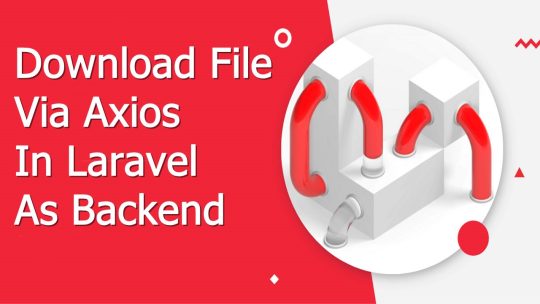
View On WordPress
#how to download pdf in vue js#vue axios download file#vue download file from assets#vue download pdf from api#vue js download file from api#vue js download zip file#vuejs download file from server#vuetify download file
0 notes
Text
Javascript rss feed reader

#JAVASCRIPT RSS FEED READER HOW TO#
#JAVASCRIPT RSS FEED READER INSTALL#
#JAVASCRIPT RSS FEED READER FULL#
#JAVASCRIPT RSS FEED READER CODE#
After that, we will have an object with the last 10 texts from, including the whole content of each one.
#JAVASCRIPT RSS FEED READER INSTALL#
You need to install a news reader or news aggregator to use our RSS feeds. So, the solution is to make the GET request on the URL and parse it into JSON. For basic styling information for your JavaScript headlines, you can download. Web design, development, javascript, angular, react, vue, php, SEO, SEM.
#JAVASCRIPT RSS FEED READER CODE#
RSS Feed URL follows this better, it was possible to get JSON from it directly, so you could handle the result in your js code in no this option was left in the past since Cloudflare will first do a captcha-check in the JSON call. Lately we have been on a constant lookout for good RSS readers to find and. The best way to do it so far, I’ve learned, is to use the RSS Feed - which is limited to the last 10 posts. Happily, on my second thought, I found more success than on my first one. So, in summary, I couldn’t use it to get my posts and show them somewhere else. It is, indeed, something interesting, but not for me - not now, anyway.
#JAVASCRIPT RSS FEED READER FULL#
Medium API is not intended to retrieve full posts but to automate your publishing process. To accomplish this, we need a server-side script to fetch the feed, jQuery’s AJAX methods and a JavaScript timer. We want to create an RSS feed rotator with jQuery. Plus, you can organize your content with categories and tags, hide stories you don. I hope that you will be able to change these params easily. Param ‘rssnum’ means how many rss elements will be displayed at the page. One of its most standout features is that when you want to read articles from your favorite websites, NewsBlur maintains the style of the original site. This is our main page code (with 2 RSS blocks). My first thought was obvious:īut my first thought was wrong. jReader is a simple, open source, jQuery and PHP based RSS reader for you to use in your site. NewsBlur is another free RSS feed reader that works on the web, iPad, iPhone, and even Android. This page was generated by GitHub Pages.I’ve been thinking about how I can retrieve my Medium posts to use them dynamically on my personal website, or somewhere else. To add RSS feeds simply add your desired RSS feeds url to the urls.json file. On a website, the URL of an RSS feed can. We need to fetch the feed with our RSS reader application.
An RSS feed has a root element called , similar to the tag found in HTML documents.
#JAVASCRIPT RSS FEED READER HOW TO#
Technologies used JQuery RSS2Json Api How To Use This application uses RSS Feeds in the XML format to get informations and news. How to Create a RSS Reader App in JavaScript Structure of an RSS feed. It also uses JQuery and the RSS2Json API. The 40-metre vessel got into difficulty about 15km off the Catanzaro Marina in Italy. Specification & Testsĭetailed code coverage is available at. RSS-Feed-Reader This is a basic web based RSS feed reader written using HTML, CSS and Javascript. Footage has emerged of the moment a superyacht completely sank into the Mediterranean Sea. Go to the news feed site you have chosen and follow their steps to add their code to the embedded news window page. To set this up, Setup the Simple News Scroller script in your template. Using other news feeds With these examples you can use an HTML or Javascript news feed from any news source. Returns as parameter the list of feed entries ordered by most recent publish date.įor further documentation see specifications. This is a Javascript feed rather than an RSS feed. (limited by feed source or Yahoo Feed API) The textContent property gets the text content of the title element. And then we call querySelector on item with 'title' to get the title element inside each item element. Then we get all the item noes with doc.querySelectorAll. Options about format of result returned from feed sources.įields to be returned from feed source(s). Next, we call parseFromString with htmlTxt and 'text/html' to parse the text as HTML. fetch ( weatherFeedUrl, addWeatherFeedItems ) Documentation nanofeed.fetch(feed_url, success_callback) parameter RSS Feed for BBC News - World Sat Aug 20 2022. fetch ( url, function ( items ) nanofeed.

0 notes
Text
Importance of jQuery in Designer's Career
Importance of jquery in the web designing
In this blog, we will discuss what is jQuery and why should we use jQuery? So let’s proceed with the intro part initially.
Required Skills
Before learning jQuery you must have knowledge of CSS, HTML, and JavaScript. One should understand what DOM is, how DOM is manipulated, and how CSS is applied. Overall a basic understanding of front-end development along with these skills is required.
History of jQuery
jQuery came into existence in January 2006 at bar camp NYC. It was developed by John Resig. John wanted to separate JavaScript from HTML tag so that the code looks clean and becomes easier to understand. This gave him the reason to start the work on JavaScript to start the work on a JavaScript library which he named jQuery.
The first jQuery code:
<button id="test">Click</button> $("#test").click(function() { alert("Button is clicked" ); });
Popularity of jQuery
In the year 2015, jQuery was used on 63% of the top 1 million websites (according to BuiltWith), and 17% of all Internet websites.
In the year 2017, jQuery was used on 69.2% of the top 1 million websites (according to Libscore).
In the year 2018, jQuery was used on 73% of the top 1 million websites, and by 22.4% of all websites (according to BuiltWith).
As of May 2019, jQuery is used by 73% of the 10 million most popular websites (according to W3Techs).
Even the percentage of usage is so high, it's discouraged to use the library in new projects, in favor of declarative frameworks like React, Angular, or Vue. There are even websites that show how to use native APIs and that you don't need jQuery. Also, the 73% usage doesn't correlate with actual interest that is constantly dropping.
What is jQuery?
jQuery is not a new programming language, it is built on top of JavaScript. In fact, JQuery is a lightweight JavaScript library that simplifies programming with JavaScript. According to the jQuery.com website, jQuery is a fast, small and feature-rich JavaScript library. It simply makes things like HTML document traversal and manipulation even handling the animation, and Ajax much simpler with an easy-to-use API that works across a multitude of browsers.
jQuery is a JavaScript library that renders some beneficial features and protects some incompatibilities between different browsers' JavaScript implementations.
The major draw of jQuery is that it's more accessible to grasp and easier to scribble than plain JavaScript. Besides, let’s take a dive to know something about the usage of jQuery in the below section. How to use jQuery?
Why jQuery?
The most important reason behind developing jQuery is to simplify client-side scripting (i.e. coding JavaScript).
Now if you are familiar with coding JavaScript you might have faced a lot of difficulties in some situations like:
Selecting or targeting elements,
applying the style to them,
supplementing effects,
creating animations,
event handling,
navigating and manipulating DOM tree &
Developing AJAX application etc.
In other words, jQuery makes all those things simpler than JavaScript. jQuery has changed the way how JavaScript is written by millions of designers and developers all around the world.
As we discussed, jQuery helps us to focus on doing things instead of focusing on how things are done. jQuery has simplified the way of coding JavaScript.
Today most of the websites over the internet use jQuery. jQuery has a really wide community and forum. You can visit the jQuery forum by visiting this given link:
https://forum.jquery.com
There you can get help from professionals. You can ask questions and help others by just answering the questions. jQuery is continuously getting updated. A lot of professionals are developing easy-to-use plugins, which make the designer's and developers' life easy while developing websites or web applications.
So, Why you have to learn jQuery?
jQuery is easy to learn, one of the most popular JavaScript libraries. It simplifies a lot of JavaScript tasks. Moreover, it holds a wide community forum.
How to use jQuery in HTML?
Usually, jQuery comes as a single JavaScript file holding everything that comes out of the box with jQuery. Now, you know what can be included with a web page using the following markup language:
To Load Local jQuery File
<script type="text/javascript" src="jQuery-1.4.1-min.js"></script>
Ideally, this markup is kept under the <head> </head> tag of your web page, however, you are free to keep it anywhere you want.
How to link jQuery to an HTML Page?
To link a separate JS file in HTML is quite an easy task for the designers. We will see here how to link jQuery on the HTML web page.
Below is an example of HTML File which links jQuery file to a new.js
<html> <head> <style> div { height: 100px; width: 100px; background-color: red; border-radius: 5px; border: 2px solid blue; margin-left: 50px; margin-top: 50px; display: none; } </style> <script src="https://ajax.googleapis.com/ajax/libs/jquery/3.2.1/jquery.min.js"></script> <script src="new.js"></script> </head> <body> <div></div> </body> </html>
5 Reasons you should be using jQuery?
There are a lot of other JavaScript frameworks out there, but jQuery seems to be the most popular, and also the most extendable.
Many of the biggest companies on the web use jQuery are:
Microsoft
Google
IBM
Netflix
All based on the manipulation of the HTML, DOM (Document Object Model) and designed only to simplify the client-side scripting of HTML, jQuery incorporates parts of HTML & CSS. Many companies are on the jQuery bandwagon, and your company should be, as well.
Let’s proceed over those 5 reasons and grasp something amusing.
jQuery is cross-browser: When we write JavaScript by using jQuery, we don’t have to worry about is this code going to work in IE7, is it going to work in a chrome browser, or is it going to work in safari? We don’t have to worry about all those browsers compatibility issues. All that is taken care of by jQuery for us. So when we write JS using jQuery we can be assured that it is going to be worth it across all browsers. So the greatest advantage of jQuery is that it is cross-browser.
jQuery is a lot easier to use than raw JS
jQuery is extensible
jQuery simplifies and has rich Ajax support
jQuery has a large development community and many free plugins. For example- within your application, if you want to implement an auto-mate textbox. You can either write code for that from scratch or you use one of the free jQuery plugins that are available already, tested, and proven to work in.
Now let’s see how to use jQuery in our application, how to use it with your application. Here, all you have to do is:
Downloading jQuery
Navigate to your jQuery.com website
Download development jQuery file
And reference that just like any other JavaScript file within your application.
So, we navigate to jQuery.com, notice that we have this download jQuery button. Once we click on that, then we go to the download page and note on this page you will see the download button.
There are two versions of jQuery available for downloading:
Production Version- This is for your live website because it has been minified and compressed.
Development Version- This is for testing and development (uncompressed and readable code)
Note: Both versions can be downloaded from jQuery.com
The jQuery library is a single JavaScript file, and you reference it with the HTML <script> tag.
Notice that the <script> tag should be inside the <head> section.
ead> <script src="jquery-3.4.1.min.js"></script> </head>
Advantages of jQuery
When it comes to programming there is no dearth of options that are available today. jQuery is a concise cross-browser JavaScript library that is mainly used to simplify HTML scripting. jQuery is a ready-to-use JavaScript library having several visual functions such as ease-in, ease-out effects. These useful features make it one of the most preferred choices for web designers. With jQuery, you can do almost any kind of effects and animation on your website. It is also SEO-friendly and cross-browser compliant. It’s the right time to take a dive and grasp the advantages of jQuery one by one.
JavaScript enhancement without the overhead of attaining new syntax.
It holds the ability to keep the code simple, clear, readable, and usable.
The main advantage of using jQuery is that it is a lot easier to use when compared to any other javascript library.
It supports Ajax and lets you develop the templates easily.
Through some jQuery effects that are almost identical to flash, the major advantage of jQuery is that it can be optimized in terms of SEO.
Disadvantages of jQuery
It’s obvious that jQuery is not to be the Pink of Perfection. It holds many drawbacks as well. jQuery is a tool or a library of tools. It can solve problems or create problems. As said nothing is perfect so it is.
Bandwidth
Not to compatible
Better alternatives
Increased technology stack
How does jQuery help you in career growth?
If you are a front-end developer, then jQuery will add value to your profile. jQuery offers a great deal of flexibility and more power to web designers. It is widely used, it is lightweight and clean, and open-source.
Having this kind of skill will be a major advantage to web developers in the growth of career.
Features of jQuery
Now, we are going to provide you the essential features of jQuery. A designer must have knowledge regarding its features as well. Here are the features that we are going to discuss:
HTML manipulation
DOM element selection
DOM manipulation
AJAX
CSS manipulation
Animations & Effects
JASON parsing
Utilities
Extensibility through plug-ins
HTML event methods
Cross-browser support
All in All
jQuery is worth the effort, money, and time. This library can have stunning & eye-catching effects on the website. With a little coding, it will be a colossal part of web development. It holds all the impeccable tools needed to build a website that is interactive and highly engaging. Overall, this is a game-changing technology to use.
#History of jQuery#How to use jQuery in HTML#Importance of jquery in the web designing#What is jQuery
0 notes
Photo

A way to look up JavaScript operators
#514 — November 13, 2020
Unsubscribe | Read on the Web
JavaScript Weekly

10 Insights From Adopting TypeScript At Scale — A fantastic writeup (from a TC39 member, no less) of how Bloomberg (the financial media company) adopted TypeScript and now has 2,000 full-time JavaScript engineers. Curiously we also learn that Bloomberg also have their own JavaScript runtime built around the V8 engine.
Rob Palmer (TC39 and Bloomberg)
A Way to Look Up JavaScript Operators — Quick, name as many operators as you can! Got to about ten or so? This site covers about fifty with a quick explanation of each (well, except the bitwise ones).
Josh W Comeau
The Most Complete Spreadsheet Solution for JavaScript Apps — New Release: Fast enterprise JavaScript spreadsheet for delivering true spreadsheet experiences. Learn more about SpreadJS v14 including native Excel I/O, Calc Engine with 450+ functions and more. Download a free trial or view the online demos.
SpreadJS by GrapeCity, Inc. sponsor
Angular 11 Released — Are you one of the allegedly 1.7 million developers using Angular? Maybe experimental webpack 5 support, faster builds, improved hot module replacement support, and automatic inlining of fonts can tempt you onto the latest version.
Mark Techson (Google)
Babylon.js 4.2 Released: Powerful 3D Rendering Engine — Babylon.js is a particularly powerful 3D rendering engine aimed at artists, game developers, and anyone with 3D ideas to explore. New to 4.2 is a new particle editor, sprite editor, texture inspector, and more. See the playground if you want a quick play.
Babylon.js
'No More Free Work from Marak' — The creator of faker.js (a library for creating dummy data) pushing back against supporting businesses for free with his open source work has become a cause célèbre in the past week. “Pay me or fork this,” he says. Whatever your take, the topic of work vs reward in open source will remain both important and divisive.
Marak X
��️ Quick bytes:
We've not had time to go through them yet, but VueConf Toronto has released a lot of talk videos from their recent online conference.
Replay is a React-inspired JavaScript game engine and they're having a game jam starting today and running for a week.
Windows user? The Windows Terminal Preview 1.5 release may interest you.
The TypeScript team have written up some notes on TypeScript's release process.
📚 Tutorials, Opinions and Stories
Rethinking the JavaScript Pipeline Operator — Dan concludes “I hope that TC39 decides to reject this proposal” but it’s interesting to see how he reaches that conclusion.
Dan Shappir
Understanding Modules and import and export Statements — Modular programming demands, well, modules, and JavaScript now has built-in support for these and here’s the basics of their operation.
Tania Rascia
Is Your JavaScript Testing Stack Holding You Back? — Learn how to boost your productivity with the ultimate development workflow.
Wallaby.js sponsor
Things I Don’t Like About Vue.js (as a React Engineer) — Well, we love Vue, but to be fair to Harry, he did write What Vue.js Does Better Than React recently too ;-)
Harry Wolff
Back to Basics: Event Delegation ��� Events don’t just occur on the element you apply them to. Instead they go all the way down the DOM tree to the event and back up again. Christian demonstrates where this can help you out.
Christian Heilmann
How to Detect When a Sticky Element Gets Pinned — …thanks to the IntersectionObserver API.
David Walsh
Live Workshop: Getting Started with OpenTelemetry in Node.js
Lightstep sponsor
▶ How to Recreate Tic Tac Toe with HTML, CSS, and JavaScript James Q Quick
You're Probably Not Using Promise.All Enough Sam Jarman
How to Create a Commenting Engine with Next.js and Sanity Bryan Robinson
▶ My VS Code Setup: Must Have Configurations and Shortcuts James Q Quick
🛠 Code & Tools
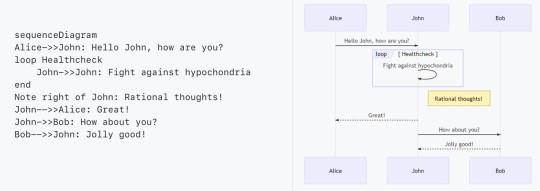
Mermaid: Markdown-'ish' Syntax for Generating Flowcharts, Sequence Diagrams, and More — Being able to ‘draw’ diagrams in a structured, text-based and have them render into something presentable is pretty appealing.
Knut Sveidqvist
jsdiff: A JavaScript Text Diffing Implementation — Can compare strings for differences in various ways including creating patches for the changes. The library is quite mature but just reached version 5.0. There’s an online demo too.
Kevin Decker
core-js 3.7.0: A Modular Standard Library and Polyfills for JS — A popular collection of polyfills covering ECMAScript features up to ES2021 level. The project has had some interesting problems recently, but releases are now flowing again.
Denis Pushkarev
CodeFix - Automatically Clean Up Technical Debt
CodeFix sponsor
React Frontload 2.0: Simple Full-Stack Data Loading for React — Do full stack data loading and state management inline in React components by writing a data loader in your component (with a hook) and it ‘just works’ with SSR and in the browser.
David Nicholas Williams
Running Vue.js in a Web Worker? — A promising prototype of running Vue.js in a Web Worker so that work is offloaded to a background thread with updates being sent back to the main thread asynchronously.
Jerzy Głowacki
Dexie.js: A Minimalistic IndexedDB Wrapper — IndexedDB is a widely supported browser API for data storage and Dexie aims to make it simpler to use (and will offer an approach for server syncing too.)
David Fahlander
Microsoft Edge Tools for VS Code — Use the Microsoft Edge Tools from within VS Code to see your site’s runtime HTML structure, alter its layout, fix styling issues as well as see your site’s network requests.
Visual Studio Marketplace
ShareDB 1.5: Realtime Database Backend Based on Operational Transformation — For when you need real time synchronization of JSON documents (such as for behind a real time collaboration app).
ShareJS
💻 Jobs
Senior / Intermediate Full Stack Developers (Sydney or Brisbane) — A SaaS business with phenomenal growth. True flexible working. You’ll have 5+ years in JavaScript / TypeScript, as well as production experience with AWS/Serverless.
Compono
JavaScript Developer at X-Team (Remote) — Join the most energizing community for developers and work on projects for Riot Games, FOX, Sony, Coinbase, and more.
X-Team
Find Your Next Job Through Vettery — Create a profile on Vettery to connect with hiring managers at startups and Fortune 500 companies. It's free for job-seekers.
Vettery
👀 A Correction
The File System Access API: Simplifying Access to Local Files — Several issues ago we mistakenly referred to this API’s spec as an ‘open standard’ when it's just a spec. It's Chrome only (for now), not a W3C standard, though it remains an interesting idea. (Thanks to reader Šime Vidas for noting our mistake and noting that the path from the WICG to a W3C standard is a long one indeed!)
Pete LePage and Thomas Steiner
by via JavaScript Weekly https://ift.tt/2IzXSPs
0 notes
Link
In 2020, we are blessed with a number of frameworks and libraries to help us with web development. But there wasn't always so much variety. Back in 2005, a new scripting language called Mocha was created by a guy named Brendan Eich. Months after being renamed to LiveScript, the name was changed again to JavaScript. Since then, JavaScript has come a long way.
In 2010, we saw the introduction of Backbone and Angular as the first JavaScript frameworks and, by 2016, 92 per cent of all websites used JavaScript. In this article, we are going to have a look at three of the main JavaScript frameworks (Angular, React and Vue) and their status heading into the next decade.
For some brilliant resources, check out our list of top web design tools, and this list of excellent user testing software, too.
01. Angular
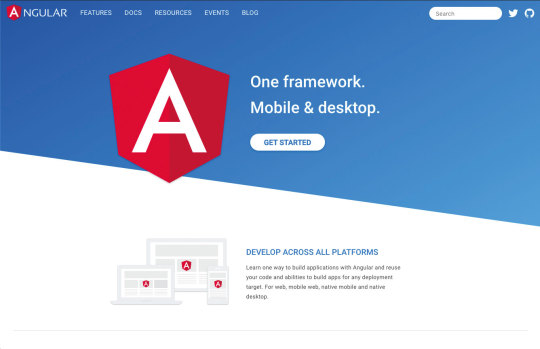
AngularJS was released in 2010 but by 2016 it was completely rewritten and released as Angular 2. Angular is a full- blown web framework developed by Google, which is used by Wix, Upwork, The Guardian, HBO and more.
Pros:
Exceptional support for TypeScript
MVVM enables developers to separate work on the same app section using the same set of data
Excellent documentation
Cons:
Has a bit of a learning curve
Migrating from an old version can be difficult.
Updates are introduced quite regularly meaning developers need to adapt to them
What's next?
In Angular 9, Ivy is the default compiler. It's been put in place to solve a lot of the issues around performance and file size. It should make applications smaller, faster and simpler.
When you compare previous versions of Angular to React and Vue, the final bundle sizes were a lot a bigger when using Angular. Ivy also makes Progressive Hydration possible, which is something the Angular team showed off at I/O 2019. Progressive Hydration uses Ivy to load progressively on the server and the client. For example, once a user begins to interact with a page, components' code along with any runtime is fetched piece by piece.
Ivy seems like the big focus going forward for Angular and the hope is to make it available for all apps. There will be an opt-out option in version 9, all the way through to Angular 10.
02. React

React was initially released in 2013 by Facebook and is used for building interactive web interfaces. It is used by Netflix, Dropbox, PayPal and Uber to name a few.
Pros:
React uses the virtual DOM, which has a positive impact on performance
JSX is easy to write
Updates don't compromise stability
Cons:
One of the main setbacks is needing third-party libraries to create more complex apps
Developers are left in the dark on the best way to develop
What's next?
At React Conf 2019, the React team touched on a number of things they have been working on. The first is Selective Hydration, which is where React will pause whatever it's working on in order to prioritise the components that the user is interacting with. As the user goes to interact with a particular section, that area will be hydrated. The team has also been working on Suspense, which is React's system for orchestrating the loading of code, data and images. This enables components to wait for something before they render.
Both Selective Hydration and Suspense are made possible by Concurrent Mode, which enables apps to be more responsive by giving React the ability to enter large blocks of lower priority work in order to focus on something that's a higher priority, like responding to user input. The team also mentioned accessibility as another area they have been looking at, by focusing on two particular topics – managing focus and input interfaces.
03. Vue
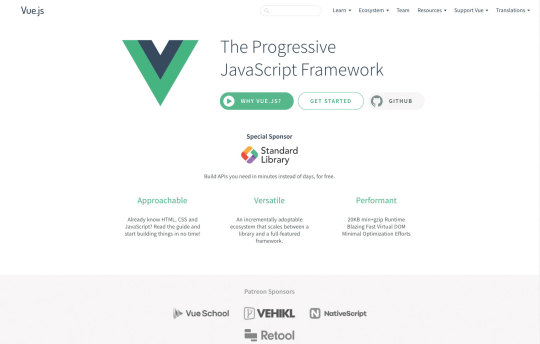
Vue was developed in 2014 by Evan You, an ex-Google employee. It is used by Xiaomi, Alibaba and GitLab. Vue managed to gain popularity and support from developers in a short space of time and without the backing of a major brand.
Pros:
Very light in size
Beginner friendly – easy to learn
Great community
Cons:
Not backed by a huge company, like React with Facebook and Angular with Google
No real structure
What's next?
Vue has set itself the target of being faster, smaller, more maintainable and making it easier for developers to target native. The next release (3.0) is due in Q1 2020, which includes a virtual DOM rewrite for better performance along with improved TypeScript Support. There is also the addition of the Composition API, which provides developers with a new way to create components and organise them by feature instead of operation.
Those developing Vue have also been busy working on Suspense, which suspends your component rendering and renders a fallback component until a condition is met.
One of the great things with Vue's updates is they sustain backward compatibility. They don't want you to break your old Vue projects. We saw this in the migration from 1.0 to 2.0 where 90 per cent of the API was the same.
How does the syntax of frameworks compare?
All three frameworks have undergone changes since their releases but one thing that's critical to understand is the syntax and how it differs. Let's have a look at how the syntax compares when it comes to simple event binding:
Vue: The v-on directive is used to attach event listeners that invoke methods on Vue instances. Directives are prefixed with v- in order to indicate that they are special attributes provided by Vue and apply special reactive behaviour to the rendered DOM. Event handlers can be provided either inline or as the name of the method.
React: React puts mark up and logic in JS and JSX, a syntax extension to JavaScript. With JSX, the function is passed as the event handler. Handling events with React elements is very similar to handling events on DOM elements. But there are some syntactic differences; for instance, React events are named using camelCase rather than lowercase.
Angular: Event binding syntax consists of a target event name within parentheses on the left of an equal sign and a quoted template statement on the right. Alternatively, you can use the on- prefix, known as the canonical form.
Popularity and market
Let's begin by looking at an overall picture of the three frameworks in regards to the rest of the web by examining stats from W3Techs. Angular is currently used by 0.4 per cent of all websites, with a JavaScript library market share of 0.5 per cent. React is used by 0.3 per cent of all websites and a 0.4 per cent JavaScript library market share and Vue has 0.3 per cent for both. This seems quite even and you would expect to see the numbers rise.
Google trends: Over the past 12 months, React is the most popular in search terms, closely followed by Angular. Vue.js is quite a way behind; however, one thing to remember is that Vue is still young compared to the other two.
Job searches: At the time of writing, React and Angular are quite closely matched in terms of job listings on Indeed with Vue a long way behind. On LinkedIn, however, there seems to be more demand for Vue developers.
Stack Overflow: If you look at the Stack Overflow Developer Survey results for 2019, React and Vue.js are both the most loved and wanted web frameworks. Angular sits down in ninth position for most loved but third most wanted.
GitHub: Vue has the most number of stars with 153k but it has the least number of contributors (283). React on the other hand has 140k stars and 1,341 contributors. Angular only has 59.6k stars but has the highest number of contributors out of the three with 1,579.
NPM Trends: The image above shows stats for the past 12 months, where you can see React has a higher number of downloads per month compared to Angular and Vue.
Mobile app development
One main focus for the big three is mobile deployment. React has React Native, which has become a popular choice for building iOS and Android apps not just for React users but also for the wider app development community. Angular developers can use NativeScript for native apps or Ionic for hybrid mobile apps, whereas Vue developers have a choice of NativeScript or Vue Native. Because of the popularity of mobile applications, this remains a key area of investment.
Other frameworks to look out for in 2020
If you want to try something new in 2020, check out these JavaScript frameworks.
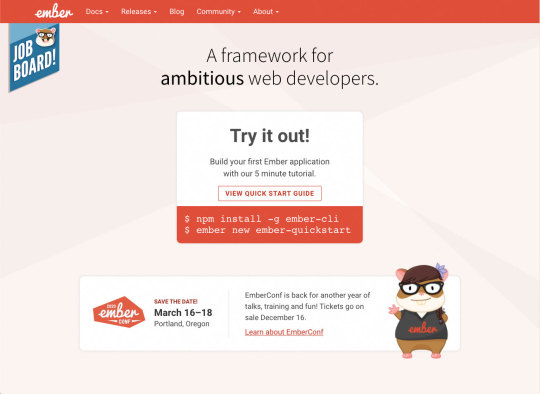
Ember: An open-source framework for building web applications that works based on the MVVM pattern. It is used by several big companies like Microsoft, Netflix and LinkedIn.
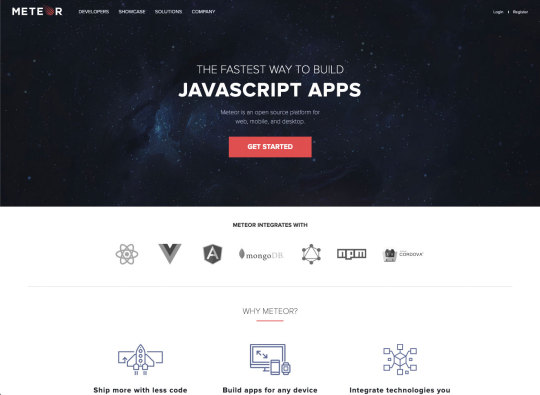
Meteor: A full-stack JavaScript platform for developing modern web and mobile applications. It's easy to learn and has a very supportive community.
Conclusion
All three frameworks are continually improving, which is an encouraging sign. Everyone has their own perspective and preferred solution about which one they should use but it really comes down to the size of the project and which makes you feel more comfortable.
The most important aspect is the continued support of their communities, so if you are planning to start a new project and have never used any of the three before, then I believe you are in safe hands with all of them. If you haven't had a chance to learn any of the three frameworks yet, then I suggest making it your New Year's resolution to start learning. The future will revolve around these three.
0 notes
Text
What’s new in Angular 8.0?

Angular 8 is the first major release from Google in the year 2019. It has focused on the toolchain and also making Angular easier for users for different applications development with performance improvements. But this, major version release also contains some new features and upgradation with respect to the previous versions. New Angular version is much lighter, faster and easier. Angular 8 supports the TypeScript version 3.4. So, using the new TypeScript version, it is easy to code with faster subsequent build with the incremental flag, type checking for globalThis, and generic type arguments. With the new release now available, it’s important to understand what has changed so you’ll know how to approach Angular 8.

New features of Angular 8-
1. Angular Ivy-
If you’re not familiar with Ivy, is it something you should think about? If the case is that, user experience of your apps is significant for you, then Ivy is definitely something you should think about. In spite of the fact that the system has made huge upgrades in file size and runtime speed since the times of Angular 2, Angular applications frequently will in general be on the substantial side with regards to file size and memory use.
Compared with the current Angular View Engine, Ivy provides the following benefits:
The code generated by the Angular compiler is now much simple to read and understand.
Rebuild times are significantly faster
Decreased payload size, so it will take browsers less time to download and parse your applications.
Better template type checking, so you can catch more errors at build time and prevent your users from encountering them at runtime
Over this, Angular Ivy aims to be broadly compatible with existing Angular applications, so preferably, you’ll have the option to get the majority of Ivy’s advantages without changing your applications at all. There will be some bugs and hiccups, however. So it’ll be helpful to develop your current Angular apps using Angular 8 and Ivy. There are some areas where Ivy is lacking—in particular, internationalization and Angular Universal support aren’t yet fully compatible. So if your Angular app supports multiple languages and additionally uses server-side rendering, don’t expect it to be ready to work with Ivy just yet.
2. Web Worker support-
As we all know that JavaScript executes in a single-threaded manner. So, to perform any huge data call or any consecutive Rest API call in an asynchronous manner is essential. But, in real application based scenario, this concept will not help us. This is because today all the web browser support the web worker process. Basically, the web worker process is the scripts executed by the browser in a separate thread. Communication with that thread in the browser tab will be carried out by sending messages. So, in general, web worker is not related to Angular from any point-of-view. But, the main point is that these scripts should be considered in the build process of the application. So, that after deployment of application the same process can be performed continuously. Hence, the main objective is to provide one single bundle for every web worker. Now, in Angular 8 this task can be performed by the Angular CLI.
Also, we can configure our Angular CLI project if we add the web worker for the first time. In this process, CLI will exclude the worker.ts files from the tsconfig.json files and also, add a new TypeScript configuration file named tsconfig.worker.json which handles the worker.ts file. Also, this information also added to the angular.json file as
“webWorkerTsConfig”: “tsconfig.worker.json”
3. Support for typescript-
Finally, Angular 8 is updates to the latest and greatest versions of Angular’s dependencies, which include tools like RxJS and TypeScript. In spite of the fact that this might seem like a small improvement, it’s also an appreciated one. Keeping up with TypeScript, in particular, is great because the TypeScript team consistently appears to pack useful new features into every release. In spite of the fact that there’s nothing preventing you from manually upgrade to the latest version of TypeScript in your projects, it’s great to see that the Angular team is keeping up with everything that TypeScript has to offer and that new apps generated via the Angular CLI will also use the newest version of TypeScript by default.
4. Bazel support-
In new version of Angular, Google introduced another build tool called Bazel. In reality, it is not a new tool. Google used this tool internally since a long time but now, they released this tool as open source. But Bazel is not totally ready in Angular 8. It is introduced as pick in choice with Angular 8 and is expected to be included in the Angular CLI in version 9.
Benefits of using Bazel-
It will provide a faster build time. Generally, It takes time for the first build but taking less time from the concurrent builds.
Using this tool, we can develop the application as an incremental build and deploy only what has been changed rather than the entire app.
We can eject the Bazel file which is normally hidden.
We can add Bazel Support using the below Angular CLI Command,
ng add @angular/bazel
Also, we can create a new app with Bazel with the help of below command,
npm install -g @angular/bazel
ng new my-app –collection=@angular/bazel
5. Differential Loading for performance optimization-
It is one of the best new features in the Angular CLI 8. Because with the assistance of these features, we will determine which browser we will target and the CLI will build the application with related necessary JS bundles with the necessary polyfills. The default target browser in the tsconfig.json file is now es2015. This means that when CLI build the application, it will build for the modern browser that supports ES6 features. But, we have to run the application in an older browser like IE9, then we have to specify it in the browser list file. This file exists in the root folder of the CLI project. Previously, it is used for the CSS part only. Now, it can be used for JS generation.
6. Changes in Lazy Loading in Route-
In Angular from the starting, the router mechanism always supports the concept of lazy loading. Till Angular 7, it was done by the string value of the loading module as below,
{
path: ‘lazy’,
loadChildren: () => ‘./admin/admin.module#AdminModule’
}
The value up to the #(hash) sign represents the path of the module file. In this the target component exists and the value after the hash sign represent the class name of that module. This style will continuously work in Angular 8. Only the way of writing lazy module has been changed. The string value of the loadchildren has been deprecated because of the support of ECMAScript and Ivy will only support this. So, now the loadchildren declaration will be like this,
{
path: ‘lazy’,
loadChildren: () => import(‘./admin/admin.module’).then(m => m.AdminModule)
}
7. Use Analytics Data-
In Angular 8, Angular CLI use analytics data so that Angular team can prioritize the features and improvements. So, when we update the CLI projects, it will opt-in with ng analytics on options. If we allow this globally, then it will collect some data like command used, the flag used, Operating System, Node Version, CPU Count, RAM Size, execution time and error with crash data if any to the Angular team for the improvement purpose in the future releases.
8. Support SVG Template-
Now, Angular 8 supports the template features with a file extension SVG. This means that, we can use the SVG extension file as a template in place of HTML file without any extra configuration settings. But why we will use a .svg file as a template instead of using the image in an HTML file? The reason is when we use SVG as a template, then we can use that as a directive and as a result, we can bind it just like HTML templates. With this approach, we can dynamically generate interactive graphics in our Angular Applications.
@Component({
selector: “app-icon”,
templateUrl: “./icon.component.svg”,
styleUrls: [“./icon.component.css”]
})
export class DashboardComponent {…}
9. PNPM Support-
In Angular 8, Angular CLI also support PNPM including NPM and Yarn. Also, in the command ng add now provide a new flag called – registry for adding packages from any private NPM registry. This command is already available in the Angular CLI version for ng update command.
Conclusion-
These are the new features in Angular 8, that you can use for effective development. If your apps are going to need changes, it’s better to find out immediately than to wait. You can know the comparison between Angular, React and Vue at out blog- Angular vs. React vs. Vue: A 2019 Comparison (Updated).
Are you looking to develop software with Angular? We suggest you the development with Angular 8. Solace is the perfect place to start with. Developers at Solace are well trained in Angular 8 development to give you the best solution. Get a free quote for software development that helps your business to stand out in the wide market competition.
0 notes
Text
Designing And Building A Progressive Web Application Without A Framework (Part 1)
Designing And Building A Progressive Web Application Without A Framework (Part 1)
Ben Frain
2019-07-23T14:00:59+02:002019-07-23T12:07:36+00:00
How does a web application actually work? I don’t mean from the end-user point of view. I mean in the technical sense. How does a web application actually run? What kicks things off? Without any boilerplate code, what’s the right way to structure an application? Particularly a client-side application where all the logic runs on the end-users device. How does data get managed and manipulated? How do you make the interface react to changes in the data?
These are the kind of questions that are simple to side-step or ignore entirely with a framework. Developers reach for something like React, Vue, Ember or Angular, follow the documentation to get up and running and away they go. Those problems are handled by the framework’s box of tricks.
That may be exactly how you want things. Arguably, it’s the smart thing to do if you want to build something to a professional standard. However, with the magic abstracted away, you never get to learn how the tricks are actually performed.
Don’t you want to know how the tricks are done?
I did. So, I decided to try building a basic client-side application, sans-framework, to understand these problems for myself.
But, I’m getting a little ahead of myself; a little background first.
Before starting this journey I considered myself highly proficient at HTML and CSS but not JavaScript. As I felt I’d solved the biggest questions I had of CSS to my satisfaction, the next challenge I set myself was understanding a programming language.
The fact was, I was relatively beginner-level with JavaScript. And, aside from hacking the PHP of Wordpress around, I had no exposure or training in any other programming language either.
Let me qualify that ‘beginner-level’ assertion. Sure, I could get interactivity working on a page. Toggle classes, create DOM nodes, append and move them around, etc. But when it came to organizing the code for anything beyond that I was pretty clueless. I wasn’t confident building anything approaching an application. I had no idea how to define a set of data in JavaScipt, let alone manipulate it with functions.
I had no understanding of JavaScript ‘design patterns’ — established approaches for solving oft-encountered code problems. I certainly didn’t have a feel for how to approach fundamental application-design decisions.
Have you ever played ‘Top Trumps’? Well, in the web developer edition, my card would look something like this (marks out of 100):
CSS: 95
Copy and paste: 90
Hairline: 4
HTML: 90
JavaSript: 13
In addition to wanting to challenge myself on a technical level, I was also lacking in design chops.
With almost exclusively coding other peoples designs for the past decade, my visual design skills hadn’t had any real challenges since the late noughties. Reflecting on that fact and my puny JavaScript skills, cultivated a growing sense of professional inadequacy. It was time to address my shortcomings.
A personal challenge took form in my mind: to design and build a client-side JavaScript web application.
On Learning
There has never been more great resources to learn computing languages. Particularly JavaScript. However, it took me a while to find resources that explained things in a way that clicked. For me, Kyle Simpson’s ‘You Don’t Know JS’ and ‘Eloquent JavaScript’ by Marijn Haverbeke were a big help.
If you are beginning learning JavaScript, you will surely need to find your own gurus; people whose method of explaining works for you.
The first key thing I learned was that it’s pointless trying to learn from a teacher/resource that doesn’t explain things in a way you understand. Some people look at function examples with foo and bar in and instantly grok the meaning. I’m not one of those people. If you aren’t either, don’t assume programming languages aren’t for you. Just try a different resource and keep trying to apply the skills you are learning.
It’s also not a given that you will enjoy any kind of eureka moment where everything suddenly ‘clicks’; like the coding equivalent of love at first sight. It’s more likely it will take a lot of perseverance and considerable application of your learnings to feel confident.
As soon as you feel even a little competent, trying to apply your learning will teach you even more.
Here are some resources I found helpful along the way:
Fun Fun Function YouTube Channel
Kyle Simpson Plural Sight courses
Wes Bos’s JavaScript30.com
Eloquent JavaScript by Marijn Haverbeke
Right, that’s pretty much all you need to know about why I arrived at this point. The elephant now in the room is, why not use a framework?
Why Not React, Ember, Angular, Vue Et Al
Whilst the answer was alluded to at the beginning, I think the subject of why a framework wasn’t used needs expanding upon.
There are an abundance of high quality, well supported, JavaScript frameworks. Each specifically designed for the building of client-side web applications. Exactly the sort of thing I was looking to build. I forgive you for wondering the obvious: like, err, why not use one?
Here’s my stance on that. When you learn to use an abstraction, that’s primarily what you are learning — the abstraction. I wanted to learn the thing, not the abstraction of the thing.
I remember learning some jQuery back in the day. Whilst the lovely API let me make DOM manipulations easier than ever before I became powerless without it. I couldn’t even toggle classes on an element without needing jQuery. Task me with some basic interactivity on a page without jQuery to lean on and I stumbled about in my editor like a shorn Samson.
More recently, as I attempted to improve my understanding of JavaScript, I’d tried to wrap my head around Vue and React a little. But ultimately, I was never sure where standard JavaScript ended and React or Vue began. My opinion is that these abstractions are far more worthwhile when you understand what they are doing for you.
Therefore, if I was going to learn something I wanted to understand the core parts of the language. That way, I had some transferable skills. I wanted to retain something when the current flavor of the month framework had been cast aside for the next ‘hot new thing’.
Okay. Now, we’re caught up on why this app was getting made, and also, like it or not, how it would be made.
Let’s move on to what this thing was going to be.
An Application Idea
I needed an app idea. Nothing too ambitious; I didn’t have any delusions of creating a business start-up or appearing on Dragon’s Den — learning JavaScript and application basics was my primary goal.
The application needed to be something I had a fighting chance of pulling off technically and making a half-decent design job off to boot.
Tangent time.
Away from work, I organize and play indoor football whenever I can. As the organizer, it’s a pain to mentally note who has sent me a message to say they are playing and who hasn’t. 10 people are needed for a game typically, 8 at a push. There’s a roster of about 20 people who may or may not be able to play each game.
The app idea I settled on was something that enabled picking players from a roster, giving me a count of how many players had confirmed they could play.
As I thought about it more I felt I could broaden the scope a little more so that it could be used to organize any simple team-based activity.
Admittedly, I’d hardly dreamt up Google Earth. It did, however, have all the essential challenges: design, data management, interactivity, data storage, code organization.
Design-wise, I wouldn’t concern myself with anything other than a version that could run and work well on a phone viewport. I’d limit the design challenges to solving the problems on small screens only.
The core idea certainly leaned itself to ‘to-do’ style applications, of which there were heaps of existing examples to look at for inspiration whilst also having just enough difference to provide some unique design and coding challenges.
Intended Features
An initial bullet-point list of features I intended to design and code looked like this:
An input box to add people to the roster;
The ability to set each person to ‘in’ or ‘out’;
A tool that splits the people into teams, defaulting to 2 teams;
The ability to delete a person from the roster;
Some interface for ‘tools’. Besides splitting, available tools should include the ability to download the entered data as a file, upload previously saved data and delete-all players in one go;
The app should show a current count of how many people are ‘In’;
If there are no people selected for a game, it should hide the team splitter;
Pay mode. A toggle in settings that allows ‘in’ users to have an additional toggle to show whether they have paid or not.
At the outset, this is what I considered the features for a minimum viable product.
Design
Designs started on scraps of paper. It was illuminating (read: crushing) to find out just how many ideas which were incredible in my head turned out to be ludicrous when subjected to even the meagre scrutiny afforded by a pencil drawing.
Many ideas were therefore quickly ruled out, but the flip side was that by sketching some ideas out, it invariably led to other ideas I would never have otherwise considered.
Now, designers reading this will likely be like, “Duh, of course” but this was a real revelation to me. Developers are used to seeing later stage designs, rarely seeing all the abandoned steps along the way prior to that point.
Once happy with something as a pencil drawing, I’d try and re-create it in the design package, Sketch. Just as ideas fell away at the paper and pencil stage, an equal number failed to make it through the next fidelity stage of Sketch. The ones that seemed to hold up as artboards in Sketch were then chosen as the candidates to code out.
I’d find in turn that when those candidates were built-in code, a percentage also failed to work for varying reasons. Each fidelity step exposed new challenges for the design to either pass or fail. And a failure would lead me literally and figuratively back to the drawing board.
As such, ultimately, the design I ended up with is quite a bit different than the one I originally had in Sketch. Here are the first Sketch mockups:
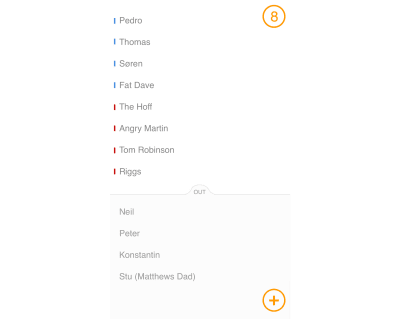
Initial design of Who’s In application (Large preview)
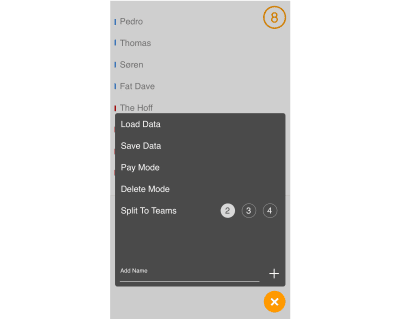
Initial menu for Who’s In application (Large preview)
Even then, I was under no delusions; it was a basic design. However, at this point I had something I was relatively confident could work and I was chomping at the bit to try and build it.
Technical Requirements
With some initial feature requirements and a basic visual direction, it was time to consider what should be achieved with the code.
Although received wisdom dictates that the way to make applications for iOS or Android devices is with native code, we have already established that my intention was to build the application with JavaScript.
I was also keen to ensure that the application ticked all the boxes necessary to qualify as a Progressive Web Application, or PWA as they are more commonly known.
On the off chance you are unaware what a Progressive Web Application is, here is the ‘elevator pitch’. Conceptually, just imagine a standard web application but one that meets some particular criteria. The adherence to this set of particular requirements means that a supporting device (think mobile phone) grants the web app special privileges, making the web application greater than the sum of its parts.
On Android, in particular, it can be near impossible to distinguish a PWA, built with just HTML, CSS and JavaScript, from an application built with native code.
Here is the Google checklist of requirements for an application to be considered a Progressive Web Application:
Site is served over HTTPS;
Pages are responsive on tablets & mobile devices;
All app URLs load while offline;
Metadata provided for Add to Home screen;
First load fast even on 3G;
Site works cross-browser;
Page transitions don’t feel like they block on the network;
Each page has a URL.
Now in addition, if you really want to be the teacher’s pet and have your application considered as an ‘Exemplary Progressive Web App’, then it should also meet the following requirements:
Site’s content is indexed by Google;
Schema.org metadata is provided where appropriate;
Social metadata is provided where appropriate;
Canonical URLs are provided when necessary;
Pages use the History API;
Content doesn’t jump as the page loads;
Pressing back from a detail page retains scroll position on the previous list page;
When tapped, inputs aren’t obscured by the on-screen keyboard;
Content is easily shareable from standalone or full-screen mode;
Site is responsive across phone, tablet and desktop screen sizes;
Any app install prompts are not used excessively;
The Add to Home Screen prompt is intercepted;
First load very fast even on 3G;
Site uses cache-first networking;
Site appropriately informs the user when they’re offline;
Provide context to the user about how notifications will be used;
UI encouraging users to turn on Push Notifications must not be overly aggressive;
Site dims the screen when the permission request is showing;
Push notifications must be timely, precise and relevant;
Provides controls to enable and disable notifications;
User is logged in across devices via Credential Management API;
User can pay easily via native UI from Payment Request API.
Crikey! I don’t know about you but that second bunch of stuff seems like a whole lot of work for a basic application! As it happens there are plenty of items there that aren’t relevant to what I had planned anyway. Despite that, I'm not ashamed to say I lowered my sights to only pass the initial tests.
For a whole section of application types, I believe a PWA is a more applicable solution than a native application. Where games and SaaS arguably make more sense in an app store, smaller utilities can live quite happily and more successfully on the web as Progressive Web Applications.
Whilst on the subject of me shirking hard work, another choice made early on was to try and store all data for the application on the users own device. That way it wouldn’t be necessary to hook up with data services and servers and deal with log-ins and authentications. For where my skills were at, figuring out authentication and storing user data seemed like it would almost certainly be biting off more than I could chew and overkill for the remit of the application!
Technology Choices
With a fairly clear idea on what the goal was, attention turned to the tools that could be employed to build it.
I decided early on to use TypeScript, which is described on its website as “… a typed superset of JavaScript that compiles to plain JavaScript.” What I’d seen and read of the language I liked, especially the fact it learned itself so well to static analysis.
Static analysis simply means a program can look at your code before running it (e.g. when it is static) and highlight problems. It can’t necessarily point out logical issues but it can point to non-conforming code against a set of rules.
Anything that could point out my (sure to be many) errors as I went along had to be a good thing, right?
If you are unfamiliar with TypeScript consider the following code in vanilla JavaScript:
console.log(`${count} players`); let count = 0;
Run this code and you will get an error something like:
ReferenceError: Cannot access uninitialized variable.
For those with even a little JavaScript prowess, for this basic example, they don’t need a tool to tell them things won’t end well.
However, if you write that same code in TypeScript, this happens in the editor:

TypeScript in action (Large preview)
I’m getting some feedback on my idiocy before I even run the code! That’s the beauty of static analysis. This feedback was often like having a more experienced developer sat with me catching errors as I went.
TypeScript primarily, as the name implies, let’s you specify the ‘type’ expected for each thing in the code. This prevents you inadvertently ‘coercing’ one type to another. Or attempting to run a method on a piece of data that isn’t applicable — an array method on an object for example. This isn’t the sort of thing that necessarily results in an error when the code runs, but it can certainly introduce hard to track bugs. Thanks to TypeScript you get feedback in the editor before even attempting to run the code.
TypeScript was certainly not essential in this journey of discovery and I would never encourage anyone to jump on tools of this nature unless there was a clear benefit. Setting tools up and configuring tools in the first place can be a time sink so definitely consider their applicability before diving in.
There are other benefits afforded by TypeScript we will come to in the next article in this series but the static analysis capabilities were enough alone for me to want to adopt TypeScript.
There were knock-on considerations of the choices I was making. Opting to build the application as a Progressive Web Application meant I would need to understand Service Workers to some degree. Using TypeScript would mean introducing build tools of some sort. How would I manage those tools? Historically, I’d used NPM as a package manager but what about Yarn? Was it worth using Yarn instead? Being performance-focused would mean considering some minification or bundling tools; tools like webpack were becoming more and more popular and would need evaluating.
Summary
I’d recognized a need to embark on this quest. My JavaScript powers were weak and nothing girds the loins as much as attempting to put theory into practice. Deciding to build a web application with vanilla JavaScript was to be my baptism of fire.
I’d spent some time researching and considering the options for making the application and decided that making the application a Progressive Web App made the most sense for my skill-set and the relative simplicity of the idea.
I’d need build tools, a package manager, and subsequently, a whole lot of patience.
Ultimately, at this point the fundamental question remained: was this something I could actually manage? Or would I be humbled by my own ineptitude?
I hope you join me in part two when you can read about build tools, JavaScript design patterns and how to make something more ‘app-like’.

(dm, yk, il)
0 notes
Text
7 Best Material Design UI Component Libraries
Material design is a popular visual design system created by Google. It aims to enable designers and developers to create applications that have a unified look on all platforms. Apps that follow material design principles look beautiful and professional on all operating systems and devices. Google’s official material design toolkit supplies you with many assets such as guidelines, components, color palettes, themes, and icons.
However, that’s just the beginning. As material design is an open-source project, third-party developers have also created their own tools following material design principles. In this article, we have collected the best material design UI component libraries that can help you a lot in your next web or mobile app project.
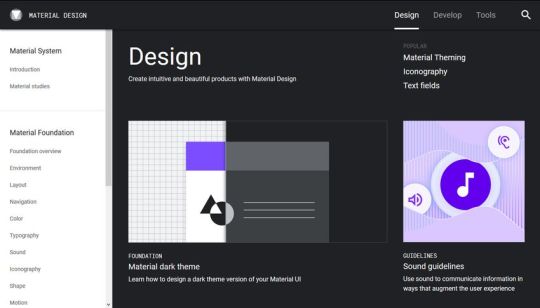
Google’s material design guidelines at Material.io
Material Design Principles
Before getting started with the best material design UI component libraries, let’s have a quick glance at the most important material design principles. They are as follows:
material color palettes typically use a primary and a secondary color,
colors need to indicate the state of components and the relationship between them,
text and icons should meet legibility standards,
motion on the screen always needs to have a meaning,
components should be reusable,
icons should have clean folds and crisp edges,
and many others.
Google made a thorough research to create the material design system and it takes some time to go through the guidelines. And, this is where the best material design UI component libraries can help you a lot. If you find one you like, you don’t have to be a material design expert to create apps that follow Google’s material guidelines.
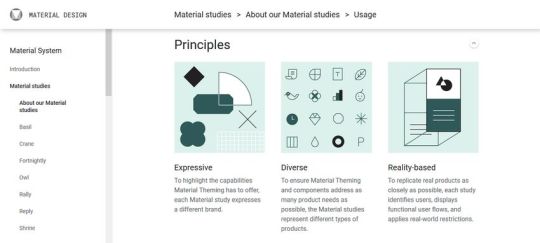
Sample from Google’s material design guidelines
The Best Material Design UI Component Libraries
Now, let’s see the best material design UI component libraries. Although you can use them for regular web development, too, they fit espcially well with Web Components and component-based JavaScript libraries such as React, Vue, Angular, and others.
1. Materialize
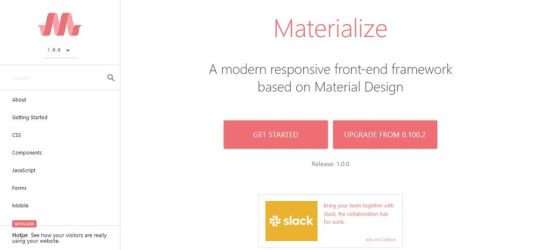
Materialize is a responsive CSS framework that follows the principles of material design. It provides you with multiple ready-to-use components such as badges, buttons, breadcrumbs, cards, icons, navigation bars, and more. Besides elements typical to websites, Materialize also includes mobile app components such as a cool drag-out menu and unobtrusive mobile alerts.
All Materialize components come with code examples you only need to add to your HTML page. Besides HTML and CSS components, you also get access to a number of customizable JavaScript elements such as a carousel, modals, parallax effects, and others. The team behind Materialize also offers themes that have been created with the component library, however they charge $19.00 – $49.00 per theme (or you can get the whole set for $59.99).
2. Material Design for Bootstrap
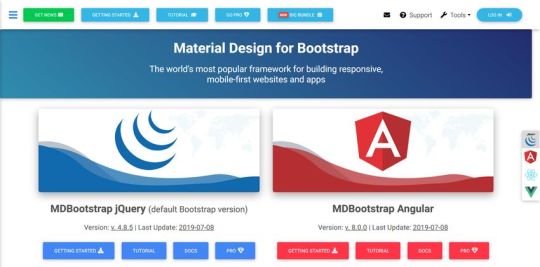
Material Design for Bootstrap is a versatile component library that allows you to build responsive, mobile-first websites and applications. It has been created for the Bootstrap 4 framework to help you use both front-end technologies at the same time. The default config uses jQuery for interactivity, however, the library also has setups for the three most popular JS frameworks: Angular, React, and Vue.
It has both a free and premium version. You can download the free material UI kit from GitHub. Currently, it includes 400+ material UI elements, 600+ material icons, 74 CSS animations, tutorials, and pre-made templates. Although the free library is more than enough for most apps, the pro version contains 4500+ premium components, 50+ premium sections, plugins, and JS modularity, too.
3. Material UI (for React)
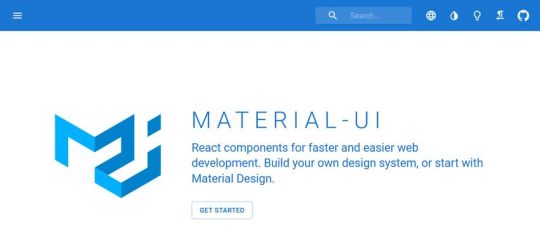
Material UI is a popular UI component library for the React framework. If you want to create any kind of React app with a material look and feel, you need not go further. The components of Material UI work out of the box, they don’t require any additional configuration. The library includes layout components, all kinds of input elements, navigation bars, surfaces, utilities, and more. For the full list of components, take a look at the documentation.
Besides having access to multiple pre-designed components, Material UI also provides you with an extensive Component API. It lets you customize all the components with the help of props and CSS customization points. Material UI’s docs are really good and easy-to-follow, with a lot of examples, code snippets, and demos, so you can quickly get started with prototyping.
4. Vue Material
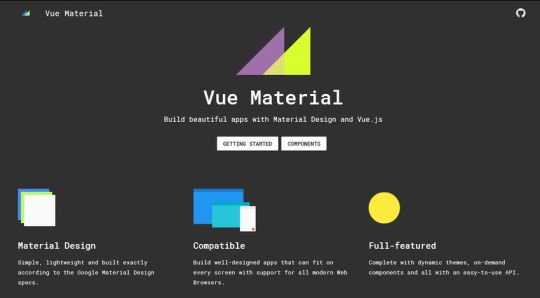
Vue Material is a lightweight material design UI component library for the Vue.js framework. Its creators take pride in having built all the components exactly according to Google’s material design specifications. Vue Material comes with tons of pre-designed UI elements such as avatars, buttons, cards, dialogs, forms, icons, lists, toolbars, and many more.
As Vue Material is pretty well-documented, it’s easy to get started with it if you worked with HTML, CSS, and Vue before. Each component is published within a live sandbox so that you can change the code online and see the results in real-time. Vue Material is a free UI component library that comes with two themes: Vue Material Dashboard Free including 16 components and the full-featured Vue Material Dashboard Pro for $59.00.
5. Angular Material
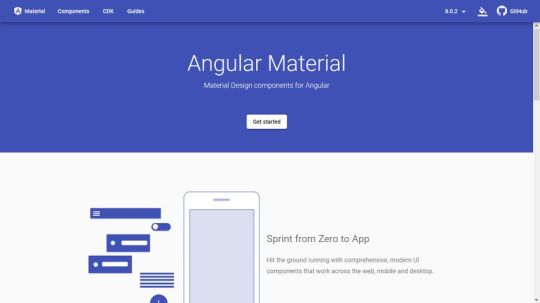
If you are on the look for a material design UI component library for your Angular application, Angular Material can be a good solution for you. It has been created by Google for the Angular 2 framework and it’s still under active development. Besides multiple UI components, Angular Material also includes the Angular Component Development Kit (CDK). Angular CDK is a toolkit that implements common interaction patterns such as accessibility, bi-directionality, drag-and-drop functionality, scrolling, and others.
Angular Material allows you to quickly prototype the user interface of any Angular application by providing you with professionally designed components created by Google. The components are categorized into six groups:
form controls,
navigation,
layout,
buttons & indicators,
popups & modals,
and data table for tabular data.
The library also comes with detailed guides that explain everything you need to know about building UIs with Angular Material.
6. MUI CSS
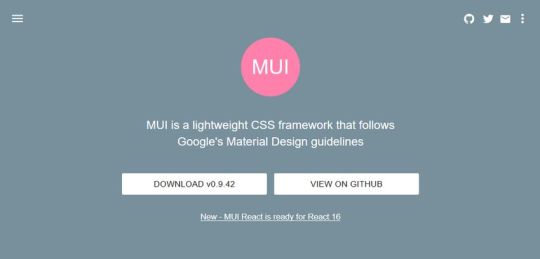
MUI CSS is a lightweight material design UI component library that includes the most important components you need in a website or application. You only need to add a minified CSS (6.6 kbyte) and JavaScript (5.4 kybte) file to your HTML page. As MUI CSS doesn’t have any external dependencies, it’s easy to set it up, even for beginners.
Besides components written in regular CSS and JS, MUI CSS has ready-to-use UI elements for React and Angular apps. The MUI CSS team has also begun to develop the beta version of a Web Components library, currently with three types of components: a HTML boilerplate, buttons, and forms. In addition, MUI CSS has a cool email UI library, too, with which you can create email templates that follow the material design guidelines.
7. Material Components for the Web
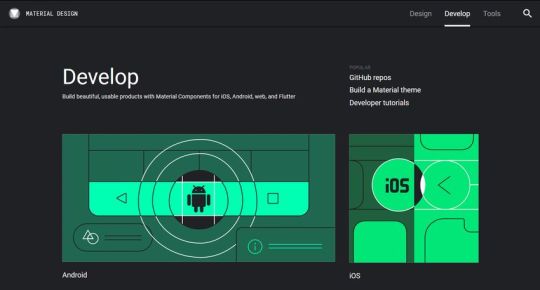
Material Components for the Web is the successor of Material Design Lite (MDL), both created by Google’s in-house team. Google’s documention on GitHub even refers the Material Components for the Web library as MDL v2. So, if you were thinking about using MDL for your project, use this library instead, as MDL vs1 is already in limited support mode.
You can find Google’s Material Components on the same material.io website where Google hosts its material design guidelines mentioned above in the article. You get access to pre-designed material UI components for four platforms:
Android,
iOS,
web,
and Flutter.
The web library provides you with a wide range of UI components such as buttons, cards, grids, surfaces, menus, tabs, and many others. If you want to create a web or mobile app that looks like Google’s own applications, the Material Components for the Web library can be the best solution for you.
Conclusion
Material design can give a professional look and feel to any web or mobile application. It’s especially a good choice if you want to build apps for the same brand for different platforms.
Creating a good-looking UI can be quite a challenge. With the best material design UI component libraries, you can follow Google’s material design guidelines without being an experienced designer.
If you are a programmer who usually works with back-end languages but want to know more about how to use UI frameworks, check out or backend developer’s guide to UI design, too.
This post comes from Digital Marketing Warrington
0 notes
Text
Best Material Design UI Component Libraries for Your Next Project
Material design is a popular visual design system created by Google. It aims to enable designers and developers to create applications that have a unified look on all platforms. Apps that follow material design principles look beautiful and professional on all operating systems and devices. Google’s official material design toolkit supplies you with many assets such as guidelines, components, color palettes, themes, and icons.
However, that’s just the beginning. As material design is an open-source project, third-party developers have also created their own tools following material design principles. In this article, we have collected the best material design UI component libraries that can help you a lot in your next web or mobile app project.
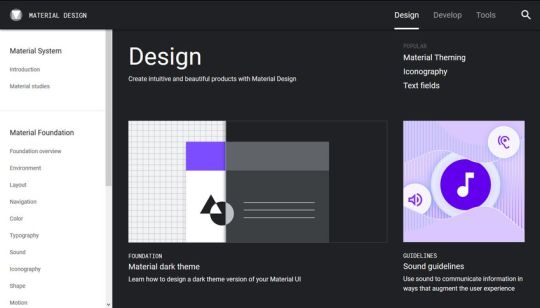
Google’s material design guidelines at Material.io
Material Design Principles
Before getting started with the best material design UI component libraries, let’s have a quick glance at the most important material design principles. They are as follows:
material color palettes typically use a primary and a secondary color,
colors need to indicate the state of components and the relationship between them,
text and icons should meet legibility standards,
motion on the screen always needs to have a meaning,
components should be reusable,
icons should have clean folds and crisp edges,
and many others.
Google made a thorough research to create the material design system and it takes some time to go through the guidelines. And, this is where the best material design UI component libraries can help you a lot. If you find one you like, you don’t have to be a material design expert to create apps that follow Google’s material guidelines.
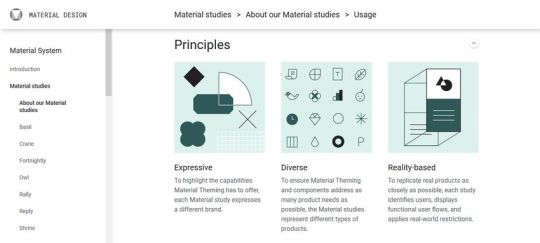
Sample from Google’s material design guidelines
The Best Material Design UI Component Libraries
Now, let’s see the best material design UI component libraries. Although you can use them for regular web development, too, they fit espcially well with Web Components and component-based JavaScript libraries such as React, Vue, Angular, and others.
1. Materialize
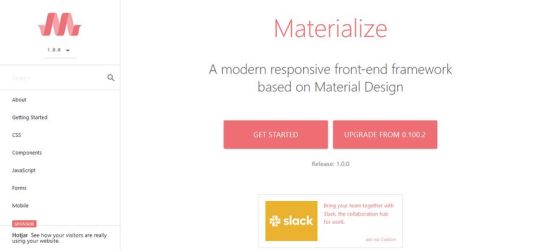
Materialize is a responsive CSS framework that follows the principles of material design. It provides you with multiple ready-to-use components such as badges, buttons, breadcrumbs, cards, icons, navigation bars, and more. Besides elements typical to websites, Materialize also includes mobile app components such as a cool drag-out menu and unobtrusive mobile alerts.
All Materialize components come with code examples you only need to add to your HTML page. Besides HTML and CSS components, you also get access to a number of customizable JavaScript elements such as a carousel, modals, parallax effects, and others. The team behind Materialize also offers themes that have been created with the component library, however they charge $19.00 – $49.00 per theme (or you can get the whole set for $59.99).
2. Material Design for Bootstrap
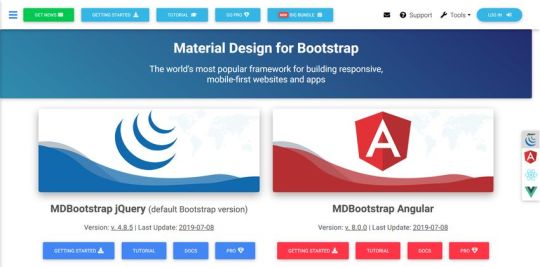
Material Design for Bootstrap is a versatile component library that allows you to build responsive, mobile-first websites and applications. It has been created for the Bootstrap 4 framework to help you use both front-end technologies at the same time. The default config uses jQuery for interactivity, however, the library also has setups for the three most popular JS frameworks: Angular, React, and Vue.
It has both a free and premium version. You can download the free material UI kit from GitHub. Currently, it includes 400+ material UI elements, 600+ material icons, 74 CSS animations, tutorials, and pre-made templates. Although the free library is more than enough for most apps, the pro version contains 4500+ premium components, 50+ premium sections, plugins, and JS modularity, too.
3. Material UI (for React)
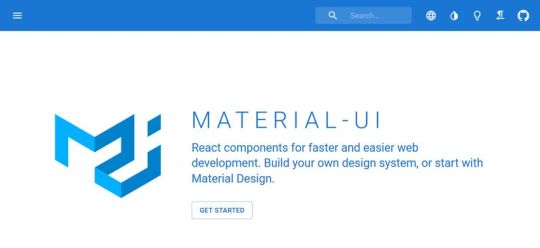
Material UI is a popular UI component library for the React framework. If you want to create any kind of React app with a material look and feel, you need not go further. The components of Material UI work out of the box, they don’t require any additional configuration. The library includes layout components, all kinds of input elements, navigation bars, surfaces, utilities, and more. For the full list of components, take a look at the documentation.
Besides having access to multiple pre-designed components, Material UI also provides you with an extensive Component API. It lets you customize all the components with the help of props and CSS customization points. Material UI’s docs are really good and easy-to-follow, with a lot of examples, code snippets, and demos, so you can quickly get started with prototyping.
4. Vue Material
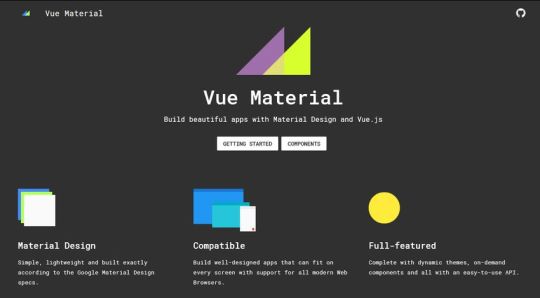
Vue Material is a lightweight material design UI component library for the Vue.js framework. Its creators take pride in having built all the components exactly according to Google’s material design specifications. Vue Material comes with tons of pre-designed UI elements such as avatars, buttons, cards, dialogs, forms, icons, lists, toolbars, and many more.
As Vue Material is pretty well-documented, it’s easy to get started with it if you worked with HTML, CSS, and Vue before. Each component is published within a live sandbox so that you can change the code online and see the results in real-time. Vue Material is a free UI component library that comes with two themes: Vue Material Dashboard Free including 16 components and the full-featured Vue Material Dashboard Pro for $59.00.
5. Angular Material
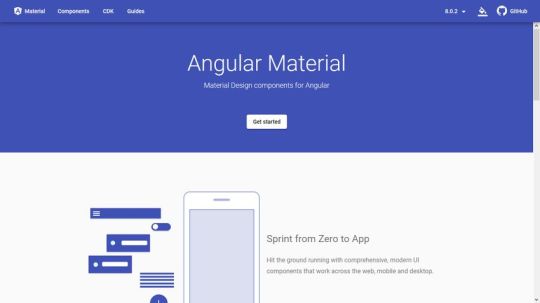
If you are on the look for a material design UI component library for your Angular application, Angular Material can be a good solution for you. It has been created by Google for the Angular 2 framework and it’s still under active development. Besides multiple UI components, Angular Material also includes the Angular Component Development Kit (CDK). Angular CDK is a toolkit that implements common interaction patterns such as accessibility, bi-directionality, drag-and-drop functionality, scrolling, and others.
Angular Material allows you to quickly prototype the user interface of any Angular application by providing you with professionally designed components created by Google. The components are categorized into six groups:
form controls,
navigation,
layout,
buttons & indicators,
popups & modals,
and data table for tabular data.
The library also comes with detailed guides that explain everything you need to know about building UIs with Angular Material.
6. MUI CSS
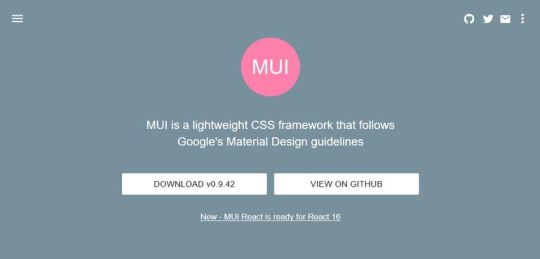
MUI CSS is a lightweight material design UI component library that includes the most important components you need in a website or application. You only need to add a minified CSS (6.6 kbyte) and JavaScript (5.4 kybte) file to your HTML page. As MUI CSS doesn’t have any external dependencies, it’s easy to set it up, even for beginners.
Besides components written in regular CSS and JS, MUI CSS has ready-to-use UI elements for React and Angular apps. The MUI CSS team has also begun to develop the beta version of a Web Components library, currently with three types of components: a HTML boilerplate, buttons, and forms. In addition, MUI CSS has a cool email UI library, too, with which you can create email templates that follow the material design guidelines.
7. Material Components for the Web
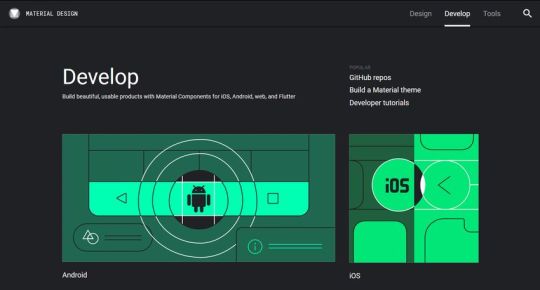
Material Components for the Web is the successor of Material Design Lite (MDL), both created by Google’s in-house team. Google’s documention on GitHub even refers the Material Components for the Web library as MDL v2. So, if you were thinking about using MDL for your project, use this library instead, as MDL vs1 is already in limited support mode.
You can find Google’s Material Components on the same material.io website where Google hosts its material design guidelines mentioned above in the article. You get access to pre-designed material UI components for four platforms:
Android,
iOS,
web,
and Flutter.
The web library provides you with a wide range of UI components such as buttons, cards, grids, surfaces, menus, tabs, and many others. If you want to create a web or mobile app that looks like Google’s own applications, the Material Components for the Web library can be the best solution for you.
Conclusion
Material design can give a professional look and feel to any web or mobile application. It’s especially a good choice if you want to build apps for the same brand for different platforms.
Creating a good-looking UI can be quite a challenge. With the best material design UI component libraries, you can follow Google’s material design guidelines without being an experienced designer.
If you are a programmer who usually works with back-end languages but want to know more about how to use UI frameworks, check out or backend developer’s guide to UI design, too.
Best Material Design UI Component Libraries for Your Next Project published first on http://7elementswd.tumblr.com/
0 notes
Text
Using Modern JavaScript frameworks with Sitecore JSS
Sitecore’s JavaScript Services (JSS) is a complete SDK for running modern JavaScript applications within a Sitecore website.
https://jss.sitecore.com
The framework supports the major UI frameworks (React, Angular, Vue) and allows front end developers to work headless (i.e. without a running Sitecore instance).
There is a lot of flexibility with JSS, key features are:
Server-side rendering (for improved performance and SEO).
Command line interface for deploying changes and getting up and running quickly.
Import service for deploying templates, etc to Sitecore from code.
Headless rendering; develop and test your components without Sitecore running.
Uses a Watch to hot load changes.
Develop using standard front end developer tools such as Visual Studio Code, npm, webpack.
Full support for Sitecore fields and placeholders (including rendering in Experience Editor).
Command line tools have a production build option to optimise the JavaScript assets for you.
Create Sitecore items using YML (e.g. for testing).
Query Sitecore content using either the GraphQL or Rest API’s.
Before getting started you will need the following:
Install Node
Install websockets in IIS for GraphQL support
Install the JSS module in Sitecore https://dev.sitecore.net/Downloads/Sitecore_JavaScript_Services.aspx
I’m going to cover two different approaches to implement React and JSS in your Sitecore website.
Code First
This approach is used to create an entire website using JavaScript and JSS. All Sitecore content (templates, placeholders, renderings, pages, etc) are defined within your JS solution, and are deployed to your Sitecore instance. An instance of Node JS then serves this up to client machines.
This would be ideal for small, JavaScript heavy micro-sites (e.g. brochure style sites). This is especially true if the team is more comfortable with developing in React rather than Sitecore.
In this example “JssReactWeb” is a full website, built purely in React:
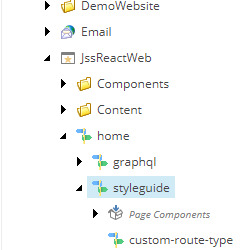
See here for a full example with instructions. This is a good boilerplate for starting your solution with:
https://github.com/Sitecore/jss/tree/dev/samples/react
JavaScript Renderings
This approach is used to implement a JSS component as a Rendering within an existing Sitecore MVC website.
This is ideal for existing Sitecore implementations that need a single custom JavaScript component rendered on the page (e.g. a graphically rich search function). Templates and Layouts are created in the traditional manner within Sitecore.
Many of the benefits of the code first approach still apply:
Supports testing the components without Sitecore running.
Can be setup with dummy test data in YML format.
Supports server-side rendering of JavaScript for improved performance and SEO support.
Sitecore Command Line Tool works the same way for build and deployment.
There are some caveats:
No code first implementation for creating the Sitecore templates/renderings, this must be done manually.
Performance may become an issue if you have many different JavaScript renderings on the same page. The recommendation is to keep it under 2 individual renderings.
Note that Sitecore are currently calling this mode experimental, read the documentation before rolling this out to a Production site.
Here is test page for a Javascript Rendering project without Sitecore running; all JS components are rendered with test data from local YML files:
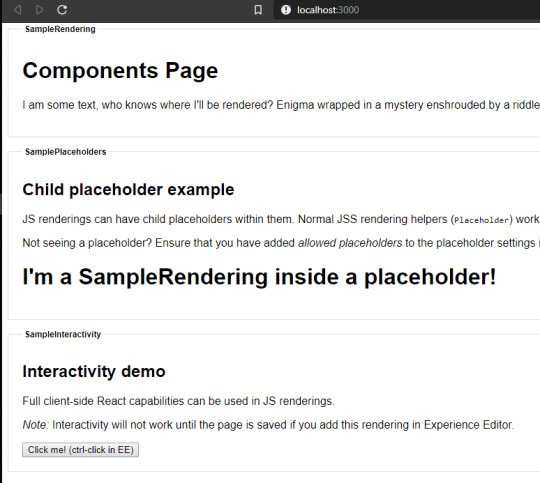
See these two links for a full example and instructions. This is a good boilerplate for starting your solution with:
https://github.com/Sitecore/jss/tree/dev/samples/sitecore-javascript-renderings
https://jss.sitecore.com/docs/techniques/mvc-integration/javascript-rendering
0 notes
Text
Introduction to Client-Side Development
Introduction to client-side elements
Distributed systems use client-side elements, so that users can interact with.
The client-side elements include,
Views – what user see
Controller – contain event handlers for the views
Client-model – business logic and data
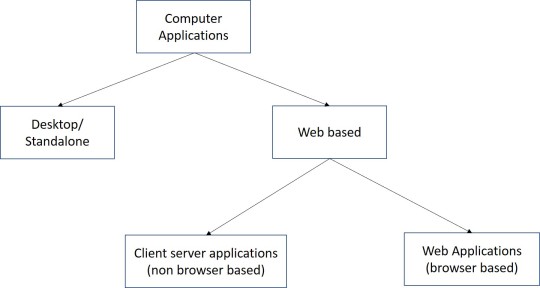
View Development
Browser-based clients’ Views comprises two main elements
Content – HTML
Formatting – CSS
HTML
HTML Elements
o Structural elements – header, footer, nav, aside
o Text elements – headings, paragraphs, line breaks
o Images
o Hyperlinks
o Data representational elements – Lists, Tables
o Form elements – Input, Radio buttons, Check boxes, Buttons
CSS (Cascading Style Sheets)
Used to decorate or format content.
Advantages:
Reduce HTML formatting tags
Easy modification
Faster loading
Save lot of work and time
Three main selectors of CSS
Element Selector
- Selects elements based on the name
ID Selector
- Uses the id attribute of HTML element to select a specific element
Class Selector
- Selects elements with a specific class attribute

Advanced selectors
Pseudo Classes Pseudo Elements
:link first-letter
:visited first-line
:hover first-child
Specificity:
Specificity is, which browser decide which css property values are the most relevant to an element and, therefore, will be applied.
Specificity is a weight that is applied to a given css declaration determined by the number of each selector type in the matching selector.
The following list of selector types increases by specificity
1. Type selector and pseudo elements
2. Class selectors, attribute selectors and pseudo classes
3. ID selectors
CSS Advanced features
Web fonts - Allow you to use custom fonts other than device fonts
Colors, gradients, backgrounds
Transformations and animations
Media
Media queries
Media queries can be used to check many things.
- Width and height of the viewport
- Width and height of the device
- Orientation
- Resolution
Can be used as
o Inline CSS
o Internal CSS sheets
o External CSS sheets
Inline CSS
Advantages:
Inline CSS can be used for many purposes, some of which include:
Testing: Many web designers use Inline CSS when they begin working on new projects, this is because its easier to scroll up in the source, rather than change the source file. Some also using it to debug their pages, if they encounter a problem which is not so easily fixed. This can be done in combination with the Important rule of CSS.
Quick-fixes: There are times where you would just apply a direct fix in your HTML source, using the style attribute, but you would usually move the fix to the relevant files when you are either able, or got the time.
Smaller Websites: The website such as Blogs where there are only limited number of pages, using of Inline CSS helps users and service provider.
Lower the HTTP Requests: The major benefit of using Inline CSS is lower HTTP Requests which means the website loads faster than External CSS.
Disadvantages
Inline CSS some of the disadvantages of which includes:
Overriding: Because they are the most specific in the cascade, they can over-ride things you didn’t intend them to.
Every Element: Inline styles must be applied to every element you want them on. So if you want all your paragraphs to have the font family “Arial” you have to add an inline style to each <p> tag in your document. This adds both maintenance work for the designer and download time for the reader.
Pseudo-elements: It’s impossible to style pseudo-elements and classes with inline styles. For example, with external and internal style sheets, you can style the visited, hover, active, and link color of an anchor tag. But with an inline style all you can style is the link itself, because that’s what the style attribute is attached to.
Internal CSS
Advantages
Since the Internal CSS have more preference over Inline CSS. There are numerous advantages of which some of important are an under:
Cache Problem: Internal styles will be read by all browsers unless they are hacked to hide from certain ones. This removes the ability to use media=all or @import to hide styles from old, crotchety browsers like IE4 and NN4.
Pseudo-elements: It’s impossible to style pseudo-elements and classes with inline styles. With Internal style sheets, you can style the visited, hover, active, and link color of an anchor tag.
One style of same element: Internal styles need not be applied to every element. So if you want all your paragraphs to have the font family “Arial” you have to add an Inline style <p> tag in Internal Style document.
No additional downloads: No additional downloads necessary to receive style information or we have less HTTP Request
Disadvantages
Multiple Documents: This method can’t be used, if you want to use it on multiple web pages.
Slow Page Loading: As there are less HTTP Request but by using the Internal CSS the page load slow as compared to Inline and External CSS.
Large File Size: While using the Internal CSS the page size increases but it helps only to Designers while working offline but when the website goes online it consumers much time as compared to offline.
External CSS
Advantages
There are many advantages for using external CSS and some of are:
Full Control of page structure: CSS allows you to display your web page according to W3C HTML standards without making any compromise with the actual look of the page.
Reduced file-size: By including the styling of the text in a separate file, you can dramatically decrease the file-size of your pages. Also, the content-to-code ratio is far greater than with simple HTML pages, thus making the page structure easier to read for both the programmer and the spiders.
Less load time: Today, when Google has included the Loading time in his algorithm, its become more important to look into the page loading time and another benefit of having low file-size pages translates into reduced bandwidth costs.
Higher page ranking: In the SEO, it is very important to use external CSS. In SEO, the content is the King and not the amount of code on a page. Search engines spider will be able to index your pages much faster, as the important information can be placed higher in the HTML document. Also, the amount of relevant content will be greater than the amount of code on a page. The search engine will not have to look too far in your code to find the real content. You will be actually serving it to the spiders “on a platter”.
There are many frameworks/libraries/plugins to support view development
o They dynamically generate HTML+CSS code
o In server and/or client side
o May have JS-based advanced interactive features
Other tools
jQuery - A JS library, but can be seen a framework too
jQuery UI - Focus on GUI development
Bootstrap - To rapidly design and develop responsive web pages and templates
Angular - A JS framework/platform to build frontend applications
React – A JavaScript library for building user interfaces
Templates are used to maintain consistency across pages in the web site/application.
Template engines are available for both server and client sides
Client-side (JS-based) template engines - NUNJUCKS, PUG, MUSTACHE.JS, HANDLEBARS
Server-side template engines - Twig, jTwig, Thymeleaf, Apache Velocity
Plug-ins
Plug-ins are mainly to add widgets to the Views
Component Development
Browser-based clients’ components comprises two main aspects
Controllers
Client-model
The components of browser-based clients are developed using JS/JS-based frameworks, libraries, and plugins.
Main features of client-side development tools
o DOM processing (dynamic content generation, change, removal)
o Data processing
o Data persistence
o Session management
o Communication
JS6 (JavaScript6)
Also called ECMAScript6
New features
JavaScript let
- The let statement allows you to declare a variable with block scope.
JavaScript const
- The const statement allows you to declare a constant
Exponentiation (**)
- The exponentiation operator (**) raises the first operand to the power of the second operand.
Default parameter values
- Default parameter values allows function parameters to have default values.
Array.find()
- The find() method returns the value of the first array element that passes a test function.
- function takes 3 arguments:
The item value
The item index
The array itself
Array.findIndex()
- The findIndex() method returns the index of the first array element that passes a test function.
- function takes 3 arguments:
The item value
The item index
The array itself
Web workers
This API is meant to be invoked by web application to spawn background workers to execute scripts which run in parallel to UI page
Web storage / Session storage
This is for persistent data storage of key-value pair data in Web clients.
GeoLocation
Identify the device location
File API
Handle the local files
Image capturing
Use local hardware
Top JS frameworks/ libraries
jQuery - Basic and simple. Cover the complexity of JS and provides cross-browser compatibility.
React - powers Facebook, Ease of Learning, DOM Binding, Reusable Components, Backward Compatibility
Angular - Support for Progressive Web Applications, Build Optimizer, Universal State Transfer API and DOM, Data Binding and MVVM
Vue – light weight, with a much-needed speed and accuracy
Generic client-side features
Form/ data validation
Dynamic content generating/updating
Some business logic
Delta communication
References
https://www.w3schools.com/css/css_syntax.asp
https://developer.mozilla.org/en-US/docs/Web/CSS/Specificity
https://www.w3schools.com/cssref/css3_pr_mediaquery.asp
https://vineetgupta22.wordpress.com/2011/07/09/inline-vs-internal-vs-external-css/
https://www.w3schools.com/js/js_es6.asp
0 notes
Text
Best Material Design UI Component Libraries for Your Next Project
Material design is a popular visual design system created by Google. It aims to enable designers and developers to create applications that have a unified look on all platforms. Apps that follow material design principles look beautiful and professional on all operating systems and devices. Google’s official material design toolkit supplies you with many assets such as guidelines, components, color palettes, themes, and icons.
However, that’s just the beginning. As material design is an open-source project, third-party developers have also created their own tools following material design principles. In this article, we have collected the best material design UI component libraries that can help you a lot in your next web or mobile app project.

Google’s material design guidelines at Material.io
Material Design Principles
Before getting started with the best material design UI component libraries, let’s have a quick glance at the most important material design principles. They are as follows:
material color palettes typically use a primary and a secondary color,
colors need to indicate the state of components and the relationship between them,
text and icons should meet legibility standards,
motion on the screen always needs to have a meaning,
components should be reusable,
icons should have clean folds and crisp edges,
and many others.
Google made a thorough research to create the material design system and it takes some time to go through the guidelines. And, this is where the best material design UI component libraries can help you a lot. If you find one you like, you don’t have to be a material design expert to create apps that follow Google’s material guidelines.

Sample from Google’s material design guidelines
The Best Material Design UI Component Libraries
Now, let’s see the best material design UI component libraries. Although you can use them for regular web development, too, they fit espcially well with Web Components and component-based JavaScript libraries such as React, Vue, Angular, and others.
1. Materialize

Materialize is a responsive CSS framework that follows the principles of material design. It provides you with multiple ready-to-use components such as badges, buttons, breadcrumbs, cards, icons, navigation bars, and more. Besides elements typical to websites, Materialize also includes mobile app components such as a cool drag-out menu and unobtrusive mobile alerts.
All Materialize components come with code examples you only need to add to your HTML page. Besides HTML and CSS components, you also get access to a number of customizable JavaScript elements such as a carousel, modals, parallax effects, and others. The team behind Materialize also offers themes that have been created with the component library, however they charge $19.00 – $49.00 per theme (or you can get the whole set for $59.99).
2. Material Design for Bootstrap

Material Design for Bootstrap is a versatile component library that allows you to build responsive, mobile-first websites and applications. It has been created for the Bootstrap 4 framework to help you use both front-end technologies at the same time. The default config uses jQuery for interactivity, however, the library also has setups for the three most popular JS frameworks: Angular, React, and Vue.
It has both a free and premium version. You can download the free material UI kit from GitHub. Currently, it includes 400+ material UI elements, 600+ material icons, 74 CSS animations, tutorials, and pre-made templates. Although the free library is more than enough for most apps, the pro version contains 4500+ premium components, 50+ premium sections, plugins, and JS modularity, too.
3. Material UI (for React)

Material UI is a popular UI component library for the React framework. If you want to create any kind of React app with a material look and feel, you need not go further. The components of Material UI work out of the box, they don’t require any additional configuration. The library includes layout components, all kinds of input elements, navigation bars, surfaces, utilities, and more. For the full list of components, take a look at the documentation.
Besides having access to multiple pre-designed components, Material UI also provides you with an extensive Component API. It lets you customize all the components with the help of props and CSS customization points. Material UI’s docs are really good and easy-to-follow, with a lot of examples, code snippets, and demos, so you can quickly get started with prototyping.
4. Vue Material

Vue Material is a lightweight material design UI component library for the Vue.js framework. Its creators take pride in having built all the components exactly according to Google’s material design specifications. Vue Material comes with tons of pre-designed UI elements such as avatars, buttons, cards, dialogs, forms, icons, lists, toolbars, and many more.
As Vue Material is pretty well-documented, it’s easy to get started with it if you worked with HTML, CSS, and Vue before. Each component is published within a live sandbox so that you can change the code online and see the results in real-time. Vue Material is a free UI component library that comes with two themes: Vue Material Dashboard Free including 16 components and the full-featured Vue Material Dashboard Pro for $59.00.
5. Angular Material

If you are on the look for a material design UI component library for your Angular application, Angular Material can be a good solution for you. It has been created by Google for the Angular 2 framework and it’s still under active development. Besides multiple UI components, Angular Material also includes the Angular Component Development Kit (CDK). Angular CDK is a toolkit that implements common interaction patterns such as accessibility, bi-directionality, drag-and-drop functionality, scrolling, and others.
Angular Material allows you to quickly prototype the user interface of any Angular application by providing you with professionally designed components created by Google. The components are categorized into six groups:
form controls,
navigation,
layout,
buttons & indicators,
popups & modals,
and data table for tabular data.
The library also comes with detailed guides that explain everything you need to know about building UIs with Angular Material.
6. MUI CSS

MUI CSS is a lightweight material design UI component library that includes the most important components you need in a website or application. You only need to add a minified CSS (6.6 kbyte) and JavaScript (5.4 kybte) file to your HTML page. As MUI CSS doesn’t have any external dependencies, it’s easy to set it up, even for beginners.
Besides components written in regular CSS and JS, MUI CSS has ready-to-use UI elements for React and Angular apps. The MUI CSS team has also begun to develop the beta version of a Web Components library, currently with three types of components: a HTML boilerplate, buttons, and forms. In addition, MUI CSS has a cool email UI library, too, with which you can create email templates that follow the material design guidelines.
7. Material Components for the Web

Material Components for the Web is the successor of Material Design Lite (MDL), both created by Google’s in-house team. Google’s documention on GitHub even refers the Material Components for the Web library as MDL v2. So, if you were thinking about using MDL for your project, use this library instead, as MDL vs1 is already in limited support mode.
You can find Google’s Material Components on the same material.io website where Google hosts its material design guidelines mentioned above in the article. You get access to pre-designed material UI components for four platforms:
Android,
iOS,
web,
and Flutter.
The web library provides you with a wide range of UI components such as buttons, cards, grids, surfaces, menus, tabs, and many others. If you want to create a web or mobile app that looks like Google’s own applications, the Material Components for the Web library can be the best solution for you.
Conclusion
Material design can give a professional look and feel to any web or mobile application. It’s especially a good choice if you want to build apps for the same brand for different platforms.
Creating a good-looking UI can be quite a challenge. With the best material design UI component libraries, you can follow Google’s material design guidelines without being an experienced designer.
If you are a programmer who usually works with back-end languages but want to know more about how to use UI frameworks, check out or backend developer’s guide to UI design, too.
Best Material Design UI Component Libraries for Your Next Project published first on https://deskbysnafu.tumblr.com/
0 notes
Text
22+ React Developer Tools to Increase Your Programming Productivity [Updated 2021]
New Post has been published on https://flatlogic.com/blog/22-react-developer-tools-to-increase-your-programming-productivity-updated-2021/
22+ React Developer Tools to Increase Your Programming Productivity [Updated 2021]
React Developer Tools Reactide Belle react-styleguidist React Material template React Semantic UI Profiler React Component Benchmark React Developer Toolbox React Bootstrap Admin template Sing App Periscope React wastage Monitor React Studio Atom React Plugin React Extension pack React Style generator Flatlogic One React React Testing Library React Monocle React + Redux kit React Boilerplate Storybook React-Sight
Conclusion
As you can understand from the title of this article, the goal is to be more productive developing React applications. That is why a long intro is unnecessary.
There are only two points that I want to highlight at the very beginning of the article:
This list is opinionated. That means first of all that you can make your additions. I am sure that it can be extended to 30 or even 40 React developer tools. That is why your comments on Facebook or Twitter are highly appreciated. This article can be useful first of all to beginners. That is why I provide some additional historical or background information about React.js in some paragraphs.
React Developer Tools
Reactide
Github stars: 9662 Web-site: http://reactide.io/
Image source: http://reactide.io/
Reactide is an integrated development environment (IDE) for web developers using React.js. If you use this tool, you don’t need server configuration as well as build-tool. Reactide is a React developer tool, it is simply a desktop application that offers great opportunities for visualization thought live code editing.
In Flatlogic we create web & mobile application templates built with Laravel, React, Vue, Angular and Bootstrap to help you develop web & mobile apps faster. Go and check out yourself! See our themes!
Belle
Web-site: http://nikgraf.github.io/belle
Image source: http://nikgraf.github.io/belle/#/?_k=744r8m
This open-source library was built by the members of React community. Belle is a UI framework that was built because of the difficulties with creating a decent UI with React in a short period. Too much freedom with React can lead to a giant waste of time. And that is where the opinionated component library Belle comes in handy. You can easily customize these components, and think only about the features you need to have. Mobile support and consistent API complying with React are also two big pluses of this React dev tool.
react-styleguidist
Web-site: https://react-styleguidist.js.org/docs/getting-started
React development environment. You need to install webpack in order to use this tool. You can see some examples here and here.
React Material Admin
Web-site: https://flatlogic.com/templates/react-material-admin
Image source: https://flatlogic.com/templates/react-material-admin
Admin template is a great React development tool that simplifies the process of coding. The benefits of using admin templates are well known. This particular admin dashboard follows Google material design guidelines. It is completely jQuery and Bootstrap free and can be used for fast development of almost any kind of web application.
Basic Tables; React Router;
Charts; Authentication; Basic Dashboard; Notifications bar.
Do you like this article?
You might want to read “19 Online Tools for Creating Charts”
React Semantic UI
Web-site: https://react.semantic-ui.com/
Image source: https://react.semantic-ui.com/
There is an original Semantic UI library. And to use it in React you need to use a React integration of this library and Semantic UI CSS package. It will help to speed up the development process because of the prebuilt UI components. React Semantic UI is jQuery-free. As you probably know jQuery is a library for DOM manipulation. That is why it is unnecessary to keep real DOM in sync with virtual DOM (React uses JS representation of the real DOM).
Among other features semantic UI React has:
Declarative API Shorthand Props Sub Components Augmentation Auto Controlled State
Profiler
Web-site: https://github.com/reactjs/rfcs/pull/51
Image source: https://reactjs.org/blog/2018/09/10/introducing-the-react-profiler.html
Two years ago the React team introduced Profiler. It gives you a summary of re-rendering of your app. You can increase your debugging performance using this “recording” your set of interactions with the help of this profiling feature. You will be able to see a visualization of re-render as well as screenshots of DOM update.
React Component Benchmark
Web-site: https://github.com/paularmstrong/react-component-benchmark
Image source: https://github.com/paularmstrong/react-component-benchmark
Do you remember react-addons-perf? This tool provided developers with insights about app performance. As the new version of React has been released you can no longer use react-addons-perf. React Component Benchmark is an open-source project that aims to solve the problem of getting an accurate benchmark metric. But it is important to understand that only large enough sample will give you a confident metric. The reason it’s happening like this is that this project does not hook into React directly. And because of this values are not accurate enough. That is why it is reasonable to run large samples using this React development tool.
React Developer Toolbox
Web-site: http://react-toolbox.io/#/
Image source: http://react-toolbox.io/#/
This is the best tool for developing Material Design UI. It has tons of responsive components that comply with Google Material Design guidelines. The exhaustive list you can find right here. React Toolbox is created on top CSS Modules, ES6, and Webpack. Documentation page contains all the live examples of each component so it’s very illustrative.
React Bootstrap
Web-site: https://react-bootstrap.github.io
You can make a case that bootstrap is the largest UI ecosystem in the world. So React-Bootstrap was built for compatibility with Bootstrap. This is one of the oldest libraries for React. It has Bootstrap core, rely on Bootstrap stylesheet and fully evolved side by side with React.js itself. If you want a set of accessible-by-default components React-Bootstrap is giving you much more possibilities than plain Bootstrap.
Admin Templates: Sing App React
Web-site: https://flatlogic.com/templates/sing-app-react
This fully responsive admin template was downloaded more than 1000 times. This template is versatile and was built by professional UI/UX experts. It has more than 60 ready-to-use components and provides you with intuitive framework. It can be useful for building such CRM, CMS, SAAS, etc.
Tens of Pages Fully Responsive 8 Charts Library 2 Dashboards Theme Support E-Commerce Section Static & Hover Sidebar Fully Documented Codebase
Periscope
Web-site: https://github.com/shea-hawkins/periscope
Image source: https://github.com/shea-hawkins/periscope
There isn’t much to say about this open-source project. This is monitoring for Redux applications. You can view your app at all times and adjust the timeline range.
React Wastage Monitor
Web-site: https://github.com/MalucoMarinero/react-wastage-monitor
Image source: https://github.com/MalucoMarinero/react-wastage-monitor#react-wastage-monitor
This project helps you to manage performance issues by detecting wasted rendering time. To understand the importance of this tool you need to dive deep into the concept of <PureComponent>. Implementing PureComponent stops the process called React reconciliation (you can read more here). And PureComponent only re-render when it’s necessary. If you rely on Redux managing to access possible performance mistakes you risk making a critical mistake. React Wastage Monitor ensures you never waste computation on unnecessary renders.
React Studio
Web-site: https://reactstudio.com/
Image source: https://reactstudio.com
React Studio is a useful tool for web developers and web designers. Web developers can enjoy clean JS code, good visual design representation that respects React.js concepts. You can design separate UI components using the code generator. A designer can enjoy responsive layouts that can be easily turned into React code, mobile preview and use it as a prototyping tool. You can have your clean code promptly with nothing extra.
Atom React Plugin
Web-site: https://orktes.github.io/atom-react/
Image source: https://orktes.github.io/atom-react/
This is support for the Atom Editor that helps highlight JSX code. JavaScript Syntax eXtensin without the plugin is very difficult to work with. With the addition of highlighter and code folding, you can make fewer mistakes. It will help you be more productive and makes your job easier.
React Developer Tool. Extension Pack
Web-site: https://marketplace.visualstudio.com/items?itemName=jawandarajbir.react-vscode-extension-pack
Image source: https://marketplace.visualstudio.com/items?itemName=jawandarajbir.react-vscode-extension-pack
As well as the previous tool this one is used to adjust your code editor. You can speed up the development process in Visual Studio using these seven extensions:
Code snippets; An integrated npm; ES6 snippets; ESLint; File paths; IntelliSense for npm modules; A search feature for node_modules.
React Style Guide Generator
Web-site: http://pocotan001.github.io/react-styleguide-generator/#!.
Image source: http://pocotan001.github.io/react-styleguide-generator/#!.
You need to maintain a consistent style across all the pages. When a big team is working on the same project all colors, typography, paddings should be consistent. To make a convenient style guide you can use React Style Guide Generator. And even if in a couple of years you will need to make adjustments or addons to your project you can simply give a developer or agency your style guide.
Flatlogic One React
Web-site: https://flatlogic.com/templates/one-react-template
Image source: https://flatlogic.com/templates/one-react-template
This is an admin template made with React 16 and Redux. The template has a responsive layout with tens of pages and hundreds of customizable components. The designers did a good job on this product. Flatlogic One React is a good basis for creating CMS systems, SAAS, Blog/Data management solutions, E-Commerce.
Tens of Pages; Beautiful charts made with Amcharts, Echarts, and Apexcharts; Fully responsive; React 16; Redux; Login and Logout screens; Notifications & Icons; Flatlogic Typography & Icons; 2 Dashboards;
Google Maps Integrated, etc.
If you’re interested in more examples of a react template, Flatlogic team can offer them for you.
React Testing Library
Web-site: https://testing-library.com/docs/react-testing-library/example-intro
If you use create-react-app you have support of Testing Library. If you don’t, you can use npm
npm install –save-dev @testing-library/react
React Monocle
Web-site: https://github.com/team-gryff/react-monocle
Image source: https://github.com/team-gryff/react-monocle
When you work on some complex projects with tons of classes of components it is always hard to manage such a project and debug it. In this case, only a transparent structure of a project is a condition for the successful delivery of a project. React-monocle can visualize all the relationships of all the components and show you the hierarchies very fast.
React + Redux starter kit
Web-site: https://github.com/coryhouse/react-slingshot
Image source: https://github.com/coryhouse/react-slingshot
This starter kit implements React best practices. This includes:
Bundling; Minification; Testing; Lintinting; Hot reloading, etc.
The most valuable part of this project is the amount of developers expertise that was put is this boilerplate. You no longer need to make tons of difficult decisions starting from the structure of the project until the testing.
React Boilerplate
Web-site: https://www.reactboilerplate.com/
Image source: https://www.reactboilerplate.com/
When you start a new app very often create-react-app crosses your mind. But you can also use a boilerplate with all dependencies prebuilt. This ready-to-use was created by the community to maximize the development speed and therefore your effectiveness. React Boilerplate can easily work with well known Chrome Redux DevTools.
Storybook
Web-site: https://storybook.js.org
Image source: https://storybook.js.org/
Storybook helps you develop nice separate UI components. In case when you need to make some isolated from business logic this tool provides so-called sandbox. And that in this sandbox or playground (you can call it as you want) you can create components. So why it is called a storybook? Because it documents components as stories. Each story contains states. Each state can be may be compared with the visual test case. In the end, a story is simply a function. This function returns a value that is rendered to the screen.
React-Sight
Web-site: https://github.com/React-Sight/React-Sight
Image source: https://github.com/React-Sight/React-Sight
This tool fully supports Router, Redux, and Fiber, and shows your app’s hierarchy. As well as previous visualization tool it requires to React Dev Tools that can be installed as an extension in Chrome.
Finally…
JavaScript is famous for the number of tools that you can use. As time goes by you get overwhelmed and tired. You need to have a set of proven tools for your coding process. We offer you a series of articles about React.js development tools.
The post 22+ React Developer Tools to Increase Your Programming Productivity [Updated 2021] appeared first on Flatlogic Blog.
0 notes
Photo

Angular 10, data grids, randomness, and checking some boxes
#494 — June 26, 2020
Unsubscribe | Read on the Web
JavaScript Weekly

Lessons Learned Refactoring Optional Chaining Into a Large Codebase — Lea Verou, creator of Mavo, decided to refactor Mavo to use optional chaining (?.) and here’s some of what she discovered along the way. (As an aside, Lea was the subject of a neat 10 minute programming documentary recently – worth a watch!)
Lea Verou
A Little Bit of Plain JavaScript Can Do A Lot — For anyone more than happy to dive in and write JavaScript without dragging in an entire framework and tooling to manage it, there will be no surprises here, but this is a nice reminder otherwise. Do you always need a 'framework'? No.
Julia Evans
Creating a Voting App with Firestore and Wijmo — Learn how to build a realtime voting app quickly and easily with the Firestore database and Wijmo components. The app uses OAuth for authentication and allows users to submit and vote for ideas.
Wijmo by GrapeCity sponsor
Angular 10 Released — A major release for the popular Google-led framework, though smaller in scope than usual as Angular 9 only came out in February ;-) 10 gains a new date range picker, optional stricter settings, and an upgrade to TypeScript 3.9.
Stephen Fluin (Google)
What's Coming in TypeScript 4? — The first beta of TypeScript 4 is due any moment with a final release due in August. New bits and pieces include variadic tuple types, labelled tuples, short-cut assignment operators (e.g. ||=) and more.
Tim Perry
⚡️ Quick bytes:
Chrome 85's DevTools have gained better support for working with styles created by CSSOM APIs (such as by CSS-in-JS frameworks). There's also syntax autocompletion for optional chaining and highlighting for private fields.
There's nothing to see just yet, but NativeScript is coming to Ionic.
The creator of AlpineJS has written about how he's passed $100K/yr in income using GitHub Sponsors.
Did you know there's a Slack theme for VS Code? 😆
▶️ The JS Party podcast crew discusses how their use of JavaScript syntax evolves (or not) over time.
engineeringblogs.xyz is a new aggregator site (by us!) that brings together what 507 (so far) product and software engineering blogs are talking about. Worth a skim.
💻 Jobs
JavaScript Developer at X-Team (Remote) — Join X-Team and work on projects for companies like Riot Games, FOX, Coinbase, and more. Work from anywhere.
X-Team
Find a Job Through Vettery — Vettery specializes in tech roles and is completely free for job seekers. Create a profile to get started.
Vettery
📚 Tutorials, Opinions and Stories
ECMAScript Proposal: Private Static Methods and Accessors in Classes — Dr. Axel takes a look at another forthcoming language feature (in this case being at stage 3 and already supported by Babel and elsewhere).
Dr. Axel Rauschmayer
npm v7 Series: Why Keep package-lock.json? — If npm v7 is going to support yarn.lock files, then why keep package-lock.json around as well? Isaac goes into some depth as to how yarn.lock works and why it doesn’t quite suit every npm use case.
Isaac Z. Schlueter
How to Dynamically Get All CSS Custom Properties on a Page — Some fun DOM and stylesheet wrangling on display here.
Tyler Gaw
Stream Chat API & JavaScript SDK for Custom Chat Apps — Build real-time chat in less time. Rapidly ship in-app messaging with our highly reliable chat infrastructure.
Stream sponsor
Getting Started with Oak for Building HTTP Services in Deno — A comprehensive Oak with Deno tutorial for beginners (which, I guess, we all are when it comes to Deno). Oak is essentially the most popular option for building HTTP-based apps in Deno right now.
Robin Wieruch
Understanding Generators in JavaScript — Generator functions can be paused and resumed and yield multiple values over time and were introduced in ES6/ES2015.
Tania Rascia
Build a CRUD App with Vue.js, Spring Boot, and Kotlin — It’s a fact of life that not everyone is building apps with JavaScript at every level of the stack. Sometimes.. people use Java too 🤫
Andrew Hughes
▶ Creating a Basic Implemention of 'Subway Surfers' — No modules, webpack or such-like here.. just exploring the joy of throwing a game mechanic together quickly using rough and ready JavaScript. Love it.
Shawn Beaton
Rubber Duck Debugging for JavaScript Developers — When you’re stuck with something, why not talk to a rubber duck?
Valeri Karpov
🔧 Code & Tools
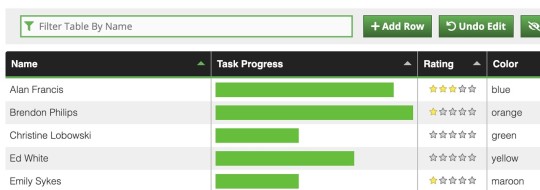
Tabulator 4.7: An Interactive Table and Data Grid Library — Supports all major browsers and can be used with Angular, Vue, and React if you wish. 4.7 is a substantial release. Among other things is a new layout mode that resizes the table container to fit the data (example).
Oli Folkerd
Tragopan: A Minimal Dependency-Free Pan/Zoom Library — Try it out here. Claims to work faster due to use of native browser scrolling for panning (left/right/up/down) and transform/scale for zooming.
team.video
Builds Run Faster on Buildkite 🏃♀️ — Build times <5 mins at any scale. Self-hosted agents work with all languages, source control tools & platforms.
Buildkite sponsor
React Query 2: Hooks for Fetching, Caching and Updating Async Data — React Query is well worth checking out and has extensive documentation and even its own devtools. Main repo.
Tanner Linsley
Rando.js: A Helper for Making Randomness Easier — The rando function lets you get random integers in a range, floats in a range, pick between multiple items, return a random element from an array, and more. There’s also randosequence for a more shuffle-like experience.
nastyox
jinabox.js: A Customizable Omnibox for AI Powered Searching — Designed to be used with a Jina back-end. It’s all open source, but will take some digging around to understand fully.
Jina AI
MongoDB Is Easy. Now Make It Powerful. Free Download for 30 Days.
Studio 3T sponsor
IntersectionObserver Visualizer — If you’re new to using the IntersectionObserver API, this useful interactive demo might help you comprehend it a little better.
michelle barker
Polly.js 5.0: Record, Replay, and Stub HTTP Interactions
Netflix
Vest: Effortless Validations Inspired by Testing Frameworks — If you’re used to unit testing, the syntax used here will be familiar.
Evyatar
👻 Scary Item of the Week
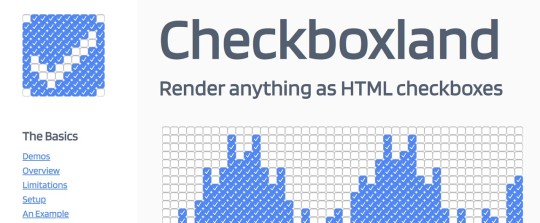
Checkboxland: Render 'Anything' as HTML Checkboxes — This frivolous experiment is equal parts terrifying and impressive. It’s a JS library that displays animations, text, and arbitrary data using nothing but HTML checkboxes and, to be fair, they’ve presented it really well!
Bryan Braun
by via JavaScript Weekly https://ift.tt/3g53MDU
0 notes
Text
The Essential Tools for Programmers
This is a list of essential tools and services from my coding workflow that I think should be part of every web programmer’s toolkit. Whether you a building a simple “Hello World” app or a complex web application, these tools should make your coding easier and increase productivity.
The Web Developer’s Toolkit
1. devdocs.io — API documentation for all popular programming languages and frameworks. Includes instant search and works offline too.
2. glitch.com — create your own web apps in the browser, import GitHub repos, use any NPM package or build on any popular frameworks and directly deploy to Firebase.
3. bundlephobia.com — quickly find the import cost (download size) of any package in the NPM registry. Or upload your package.json file to scan all dependencies in your project.
4. babeljs.io/repl — Write your code in modern JavaScript and let Babel transform your code into JavaScript that is compatible with even older browsers.
5. codeply.com — quickly build frontend responsive layouts with frameworks like Bootstrap, Materialize CSS and SemanticUI.
6. httpie.org — a command-line tool that is useful for making HTTP requests to web servers and RESTful APIs. Almost as powerful as CURL and Wget but simpler.
7. regexr.com — A good tool for testing your regular expressions in the browser.
8. jex.im/regulex — Write any regular expression into the editor and get a visual representation of how the pieces work.
9. buildregex.com — Construct regular expressions visually.
Also see: The Most Useful Websites on the Internet
10. explainshell.com — Type any Unix command and get a visual explanation of each flag and argument in the command.
11. tldr.ostera.io — Unix man pages are long and complex. This site offers practical examples for all popular Unix command without you having to dive into the man pages.
12. mockaroo.com — quickly generate dummy test data in the browser in CSV, JSON, SQL and other export formats.
13. jsdelivr.com — Serve any GitHub file or WordPress plugin through a CDN. Combine multiple files in a single URL, add “.min” to any JS/CSS file to get a minified version automatically. Also see unpkg.com.
14. carbon.now.sh — create beautiful screenshots of your source code. Offers syntax highlighting for all popular languages.
15. wakatime.com — know exactly how long you spend coding with detailed metrics per file and even language. Integrates with VS Code, Sublime text, and all popular code editors.
16. astexplorer.net — paste your JavaScript code into the editor and generate the Abstract Syntax Tree that will help you understand how the JavaScript parser works.
17. hyper.is — A better alternative to the command line terminal and also iTerm. Use with the Oh My Zsh shell and add superpowers to your terminal.
18. curlbuilder.com — make your own CURL requests in the browser.
19. htaccess.madewithlove.be — easily test the redirect and rewrite rules in the .htaccess file of your Apache server. See useful .htaccess snippets.
Also see: The Best Places to Download HTML Templates
20. trackjs.com — monitor errors in your JavaScript based web projects and get instant email notifications when a new error is detected.
21. ngrok.com — Start a local web server, fire up ngrok, point to the port where the localhost is running and get a public URL of your tunnel.
22. codeshare.io — An online code editor for pair programming, live interviews with video conferences or for teaching code to students remotely.
23. webhooks.site — Easily inspect the payloads and debug HTTP webhooks in the browser. All HTTP requests are logged in real-time. Another good alternative is RequestBin.
24. surge.sh — the easiest way to deploy web pages and other static content from the command line. Supports custom domains and SSL. Also see Zeit Now.
25. visbug — A must-have add-on for web developers that brings useful web design tools right in your browser. Available for Google Chrome and Firefox.
26. puppeteersandbox.com — Puppeteer is a Node.js framework for automating Google Chrome. Use the sandbox to quickly test your scripts in the browser. Also see try-puppeteer.com.
27. prettier.io/playground — Beautify your JavaScript and TypeScript code using Prettier, the favorite code formatter of programmers.
28. json.parser.online.fr — The only JSON parser you’ll ever need to analyze and beautify your complex JSON strings.
29. scrimba.com — Create your own programming screencasts in the browser or watch other developers code.code.
30. katacoda.com — A training platform for software developers where anyone can create their own dedicated and interactive training environments.
31. codesandbox.io — A full-featured online IDE where you can create web applications in all popular languages including vanilla JavaScript, React, TypeScript, Vue and Angular. Also see StackBlitz.com and Repl.it.
32. apify.com — Write your own web scrapers using JavaScript and schedule your scrapers to run at specific intervals automatically.
33. vim-adventures.com — The Vim text editor is hugely popular among programmers. The site will help you master the various key commands through a game.
34. insomnia.rest — A desktop based REST client that lets you create HTTP requests and view response details all in a easy-to-use interface. Advanced users may consider Postman.
Also see: The Most Awesome Teachers for Learning Web Development
The post The Essential Tools for Programmers appeared first on Digital Inspiration.
via Digital Inspiration Technology Blog https://ift.tt/2Em4psx
0 notes
Text
Customize Every Pixel: Custom Checkouts Now Available on BigCommerce
BigCommerce is excited to announce the achievement of a major platform milestone: Our Checkout SDK is now generally available.
What is the BigCommerce Checkout SDK?
The Checkout SDK is a JavaScript library that makes it easy to consume the new Checkout APIs.
The Checkout SDK is intended for partners, developers and brands who want to build a custom checkout front-end experience. It allows for developers to create their own UI to move a customer through the checkout process.
The SDK handles all the heavy-lifting such as:
Customer login
Getting shipping quotes
Submitting payment for an order
Beyond general availability of the Checkout SDK, BigCommerce is also proud to announce and showcase multiple customers using a customized checkout via the Checkout SDK and two BigCommerce partners who have built out ready-to-use customized checkout applications.
Examples of The BigCommerce Checkout SDK in Use
The BigCommerce SDK is already in use by a variety of BigCommerce customers. In addition, you can go through our open-source Cornerstone Theme demo store to see the Checkout SDK in use.
This is the Checkout SDK testing environment using BigCommerce’s open-source Cornerstone theme.
Let’s look at a few additional examples.
Yellow Pages
This custom checkout was built by Moustache Republic on the BigCommerce Checkout SDK as part of the Yellow Pages’ digital transformation.
It allows for various custom entries specific to Yellow’s use cases.
“Yellow is going through a complete digital transformation and bringing a whole new set of services online. Like most businesses their size, the company has a complex set of ecommerce requirements that can’t be solved by out-of-the-box solutions,” said Tony Hou, managing director at Moustache Republic.
“As a long-time BigCommerce partner, we knew the BigCommerce platform had the flexibility to accommodate both the customized single sign-on and checkout experiences Yellow desired, without requiring a huge investment. Features like Checkout SDK are just another way the platform allows agencies to customize a SaaS solution for unique business needs.”
Bohemian Traders
This custom checkout was built by Intuit Solutions on the BigCommerce Checkout SDK for Bohemian Traders.
Bohemian Traders was looking for a complete one-page checkout, where all fields are readily visible upon landing on the checkout.
“We worked with BigCommerce partner Intuit Solutions, which puts a skin over the BigCommerce one page checkout and rearranges all of the information,” says David Berlach, CEO of Bohemian Traders.
“Now, there are three columns on the checkout page. There is no scrolling at all. It’s clean and undistracting for the customers. Plus, we can brand it or include up-sells or cross-sells as needed. That’s been working very well.”
Kettlebell Kings
This custom checkout was built by Bolt using the Checkout SDK for Kettlebell Kings. Kettlebell Kings was looking to reduce the number of clicks to checkout for a variety of products.
Ready-to-use Customized Checkout Apps
Beyond customization for brands, agencies, developers and technology companies now have the ability to build a completely customized checkout on BigCommerce, and then market that solution as a replacement for the BigCommerce checkout on both the BigCommerce App Store and their own marketing material.
This is net new, recurring income opportunity for agencies, developers and technology companies.
Plus, this gives BigCommerce merchants even more control in their desired ecommerce checkout experience, along with the ease of use of a one-click install.
Here are two companies already building additional revenue with BigCommerce’s Checkout SDK.
Bolt
Bolt is a single, intelligent platform that replaces fragmented online shopping, payment, and fraud software. As one of BigCommerce’s preferred partners for checkout, Bolt brings a seamless checkout experience and zero fraud to online retailers, driving double-digit revenue lift.
“With BigCommerce’s Checkout SDK, BigCommerce merchants can now take advantage of Bolt Checkout without investing in additional developer hours, giving them access to Bolt’s hyper-optimized checkout interface and precision fraud detection out of the box,” said Kazuki Nishiura, head of integration engineering at Bolt.
“BigCommerce and Bolt have been working closely on this seamless integration, and we’re excited to bring our track record of 10-50 percent revenue lift to a growing number of retailers.”
According to Bolt, the benefits of their checkout solution including:
4 fewer clicks to checkout
8 fewer fields to fill out at checkout
35-90 seconds faster checkout than the average ecommerce checkout
10-50% revenue lift for online retailers.
Single-click checkout for returning customers
0 dev hours integration: Bolt does all the heavy-lifting for BigCommerce retailers
Industry-leading fraud detection, powered by machine learning and double-checked with human review
100% coverage of fraudulent chargebacks including full international risk coverage
Personalized customer support
BigCommerce customers can begin using Bolt’s checkout now.
Intuit Solutions
Intuit Solutions has long been an agency partner for BigCommerce. Now, they have repurposed their custom checkout development work into a net new app to increase the agency’s recurring revenue.
Bohemian Traders is only one of hundreds of BigCommerce merchants already using the solution.
BulkBookstore is another brand using Intuit Solutions’ One-Page Checkout.
According to Intuit Solutions, the benefits of their checkout include:
7-10% AVG Conversion Increase
45 Seconds Average Reduction In Checkout Time
No Downtime During Installation
Google Maps API Address Autofill
100% PCI Compliant and Secure
BigCommerce customers can begin using Intuit Solutions’ checkout now.
BigCommerce Checkout SDK FAQs
What can I do with the Checkout SDK?
The Checkout JS SDK provides methods for building a checkout page replacement rather than a way to make changes to the existing checkout page. Essentially, you are replacing the built-in Optimized One-Page Checkout with a totally new UI that you design and build yourself.
The SDK provides JavaScript methods for completing the necessary steps of checkout, like displaying and selecting shipping methods, and communicating that information back to the BigCommerce backend.
Here are a variety of customizations you can build:
Initialize payment and shipping providers that require client-side setup through a common interface. Below are some examples of these providers:
PayPal Express
Braintree
Stripe
Square
Amazon
Klarna
Provides a JavaScript interface for interacting with the web API.
Fetch and submit resources:
Cart
Order
Customer
Fetch available options:
Shipping addresses
Shipping countries
Shipping states
Billing addresses
Billing countries
Billing states
Shipping methods
Payment methods
It is important to note that the Checkout SDK does not allow you to change the underpinnings of the checkout. You must still conform to the model of the Checkout API underpinning the SDK to successfully complete a Checkout and create an order in BigCommerce.
The SDK does not allow you to implement custom payment, shipping, or tax calculation providers into the checkout. Instead, the configured providers for these services on a given store are expressed via our Checkout API.
Where can I get the Checkout SDK?
The Checkout SDK and associated documentation can be downloaded from the BigCommerce SDK Repo.
There, you can find documentation, installation instructions, and take a look at the code. The Checkout SDK is an open source project, so while BigCommerce actively maintains it, you can open a pull request if you’d like to contribute.
Do I have to build my custom checkout in React?
Nope! The library is vanilla JavaScript, so it’s framework-agnostic. You can work in React, Angular, Vue, or even just plain HTML and JavaScript–whichever frontend framework you prefer to build in.
How do I integrate my custom checkout into the template files?
The most common implementation will be to build a custom checkout directly into the checkout.html file, replacing the default }.
Anything else I should know?
The Checkout SDK is only supported with the Optimized One-Page Checkout control panel setting.
What if I need help?
Currently, support is provided based on your plan. Enterprise clients can reach out to their account manager. For other options on customizing the checkout see our developer documentation on the different ways of working with the checkout pages.
Commerce Without Compromise
BigCommerce is dedicated to building an ecommerce platform that allows our customers to build commerce experiences as they intend them. This means that we will continue to focus on building out our developer documentation, access to APIs, launch additional SDKs and more.
In today’s competitive retail environment, it is crucial that brands build customized end-to-end ecommerce experiences that are memorable, unique and effective for their specific audiences. It is our intention to remove any barriers that exist to using best-of-breed technologies, business models or data orchestration flows that force retailers into an opinionated ecommerce build out.
Here are additional BigCommerce product launches focused on knocking down those barriers:
BigCommerce WordPress Integration: Marrying Scalable Content and Commerce
BigCommerce Brings AMP to Sites Worldwide
Akamai Image Manager Now Available at No Cost to BigCommerce Customers
For more information on getting started with the Checkout SDK, please follow this link.
Want more insights like this?
We’re on a mission to provide businesses like yours marketing and sales tips, tricks and industry leading knowledge to build the next house-hold name brand. Don’t miss a post. Sign up for our weekly newsletter.
Customize Every Pixel: Custom Checkouts Now Available on BigCommerce published first on https://goshopmalaysia.tumblr.com
0 notes